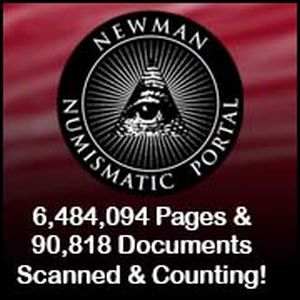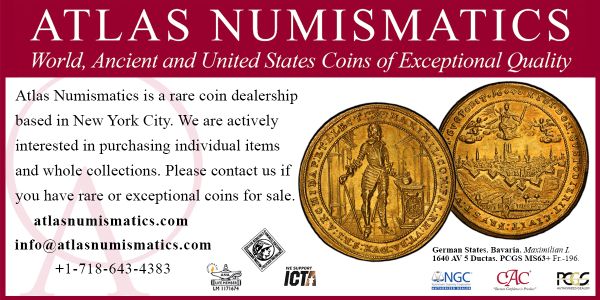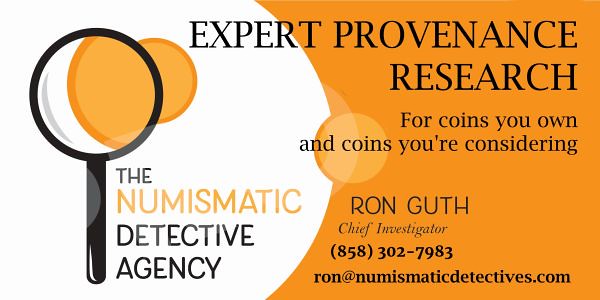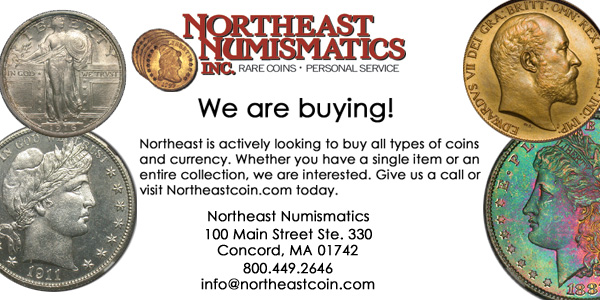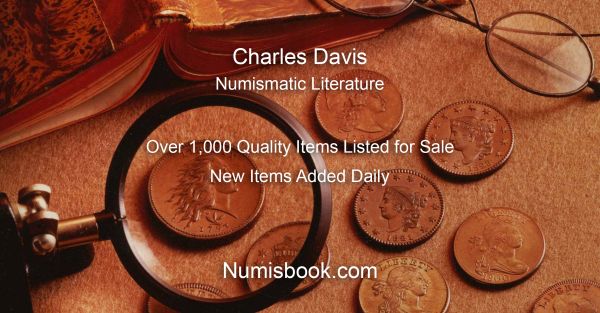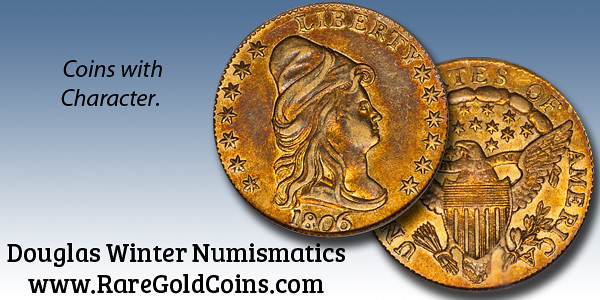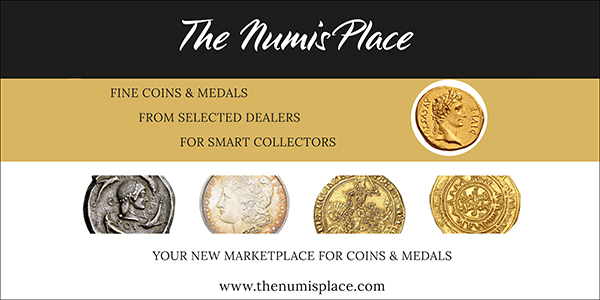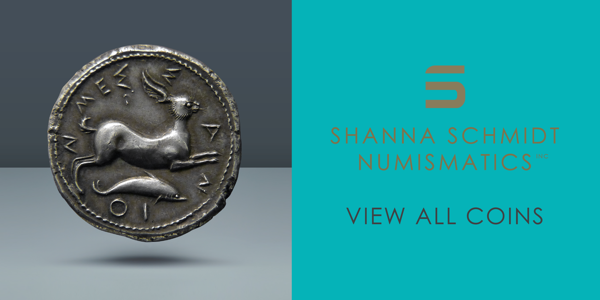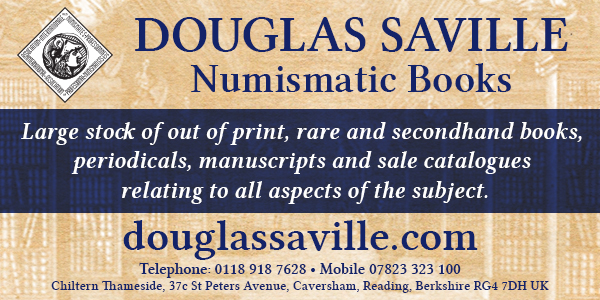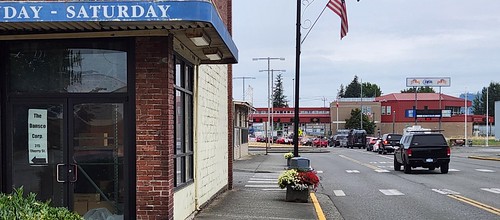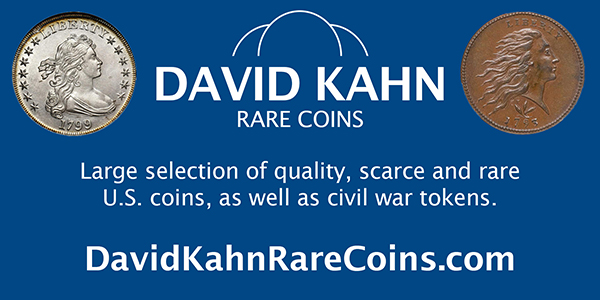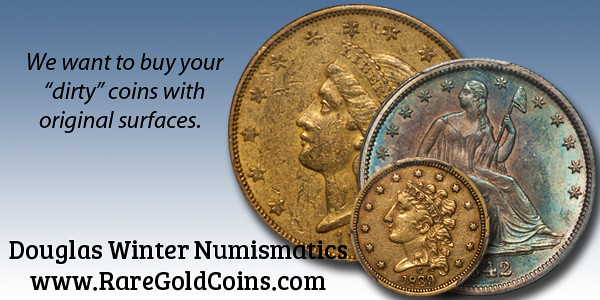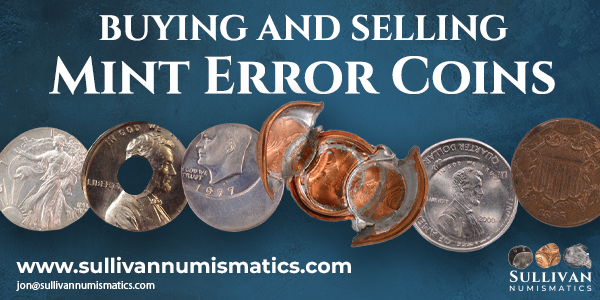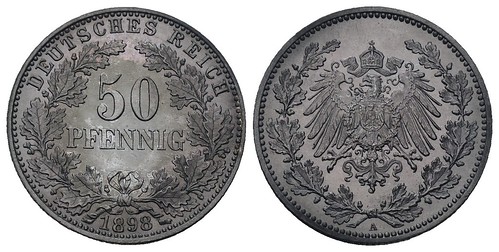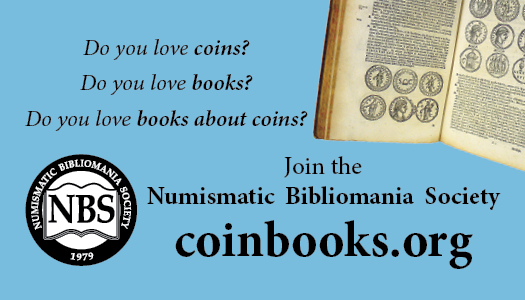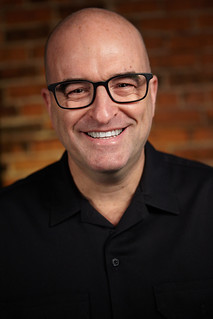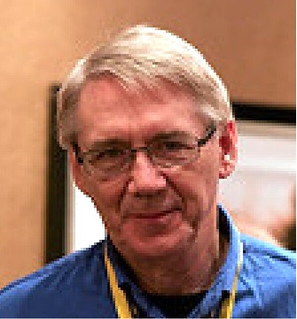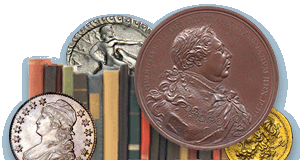
Visit our NBS Sponsors
About UsThe Numismatic Bibliomania Society is a non-profit association devoted to the study and enjoyment of numismatic literature. For more information please see our web site at coinbooks.org SubscriptionsThose wishing to become new E-Sylum subscribers can go to the following web page
Subscribe
MembershipThere is a membership application available on the web site Membership Application To join, print the application and return it with your check to the address printed on the application. Print/Digital membership is $40 to addresses in the U.S., and $60 elsewhere. A digital-only membership is available for $25. For those without web access, write to: Jeff Dickerson, Treasurer AsylumFor Asylum mailing address changes and other membership questions, contact Jeff at this email address: treasurer@coinbooks.org SubmissionsTo submit items for publication in The E-Sylum, write to the Editor at this address: whomren@gmail.com BUY THE BOOK BEFORE THE COINSale Calendar |
- WAYNE'S WORDS: THE E-SYLUM SEPTEMBER 21, 2025
- GUT-LYNT AUCTION 22 NUMISMATIC LITERATURE
- KOLBE & FANNING OCTOBER 2025 SALE ANNOUNCED
- ROBINSON AUCTION 129 NUMISMATIC LITERATURE
- NEW BOOK: WHEN COINS WERE KING
- NEW BOOK: KUSHAN COINS AND HISTORY:
- JAMES ANDREW GUINESSO (1948-2025)
- METAL TOY COINS AND MEDALETS OF GREAT BRITAIN
- VIDEO: WHITMAN PHILADELPHIA SEPTEMBER 2009
- ANA AWARDS MEDALLIC ART AND WRITING
- ACEF BESTOWS TWO KREUZER AWARDS
- HISTORY OF 1856 "UPRIGHT 5" GOLD DOLLAR
- MORE ON THE 16TH 1804 DOLLAR PROVENANCE
- MORE FULBRIGHT SCHOLARS IN NUMISMATICS
- NOTES FROM E-SYLUM READERS: SEPTEMBER 21, 2025
- VOCABULARY TERM: ROLLER DIE
- MICHAEL S. MACDOUGALL (1902-1996)
- VISITING DANSCO'S MANUFACTURING PLANT
- ATLAS NUMISMATICS SELECTIONS: SEPTEMBER 21, 2025
- NUMISMAGRAM MEDAL SELECTIONS: SEPTEMBER 21, 2025
- SOVEREIGN RARITIES AUCTION XIX SELECTIONS
- HOLABIRD SEPTEMBER 2025 SALE: NUMISMATICS
- GUT-LYNT AUCTION 22 COIN SELECTIONS I
- KUENKER AUCTION SALE 429
- COLORADO MINING NOTES
- WORLD'S COLUMBIAN EXPOSITION HOARD
- 2025 ANNUAL MCA MEDAL: ARS ET MEMORIAE
- STACKS BOWERS TO OFFER EMPEROR NORTON BONDS
- BANK OF AMERICA'S FRESNO EXPERIMENT
- FEATURED WEBSITE: JAPANESE BAR MONEY
- ABOUT THIS ISSUE: SEPTEMBER 21, 2025
Content presented in The E-Sylum is not necessarily researched or independently fact-checked, and views expressed do not necessarily represent those of the Numismatic Bibliomania Society.
WAYNE'S WORDS: THE E-SYLUM SEPTEMBER 21, 2025
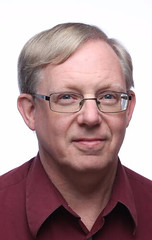 New subscribers this week include:
John Deyell, courtesy Paula Turner;
Joshua Puckey and Katie Tillyer, courtesy Steve Hill;
Steve Bienz, courtesy Rich Kelly;
Tim Fitzgerald, courtesy of Ernie Nagy;
and
Jonathan Claydon.
Welcome aboard! We now have 6,868 subscribers.
New subscribers this week include:
John Deyell, courtesy Paula Turner;
Joshua Puckey and Katie Tillyer, courtesy Steve Hill;
Steve Bienz, courtesy Rich Kelly;
Tim Fitzgerald, courtesy of Ernie Nagy;
and
Jonathan Claydon.
Welcome aboard! We now have 6,868 subscribers.
Welcome also to Heritage Auctions - a longtime supporter, Heritage is now also an official sponsor of The E-Sylum. Thank you!
Thank you for reading The E-Sylum. If you enjoy it, please send me the email addresses of friends you think may enjoy it as well and I'll send them a subscription. Contact me at whomren@gmail.com anytime regarding your subscription, or questions, comments or suggestions about our content.
This week we open with three numismatic literature sales, two new books, an obituary, updates from the Newman Numismatic Portal, the ANA and ACEF.
Other topics this week include metal toy coins, the Kreuzer awards, Fulbright scholars in numismatics, roller dies, Mickey MacDougall, DANSCO, fixed price and auction offerings, Colorado mining notes, Emperor Norton bonds, the BankAmericard, and Japanese bar money.
To learn more about the portrait of Philetairos of Pergamon, the Hyman Montagu collection of Roman and Byzantine coins, Attinelli's Numisgraphics, Kushan coins, sculptor Oleg Gavrizon, David Schenkman, Carson City Trade Dollar varieties, the Sierra Leone dollar, St. Benedict of Nursia, coins of the Dutch East Indies, and the Deaf Mute's Gyp Game, read on. Have a great week, everyone!
Wayne Homren
Editor, The E-Sylum
GUT-LYNT AUCTION 22 NUMISMATIC LITERATURE
The 22nd Gut-Lynt coin auction will take place on the first weekend in October, starting on the public holiday (German Unity Day) on 3 October 2025. For the first time, more than 5,000 lots will be offered over three auction days, including Prof. Dr. Wolfram Weiser's extensive numismatic library on Friday, 3 October at 11:30 a.m. (CEST). More than 1,100 lots, mainly relating to ancient numismatics, will be offered, including many rare and sought-after editions, whether bibliophile editions, monographs, journals or important auction catalogues. See an article elsewhere in this issue for more on the overall sale. -Garrett

Lot 618: KÖHLER; J. D. Köhlers Historischer Münz-Belustigung (Köhlers Historical Coin Entertainment). Part Three. Bound together: Part Four. Nuremberg 1731/1732. Estimate: 60 euros

Lot 625: MUSELLI, J. Numismata Antiqua a Iacobo Musellio Collecta et edita Veronae MDCCLI (1751). Volumes 1 and 2. Half leather binding. Estimate: 250 euros
Lot 779: Greeks, GORINI, G. La monetazione incusa della Magna Grecia. Milan 1975, full cloth, estimate €50
Lot 930: SNG by Aulock. Berlin 1957, 1960, 1963, 1964. Author's copies with additional blank pages between the individual plates, 6 leather copies, estimate €1,200
Lot 989: Greeks, WESTERMARK, U. The portrait of Philetairos of Pergamon. Corpus of coinage. RARE, estimate 100 euros
Lot 1753: Auction catalogues, ROLLIN & FEUARDENT, Paris. Collection of the late Mr H. Montagu, F.S.A. Vice-President of the Numismatic Society of London. Roman & Byzantine gold coins. Auction of 20 April 1896 and following. Reprint 1976. Leather. Estimate: 100 euros
Earlier on October 3, the following book will also be sold:
Lot 583: CHINA, MEIXIN, S. / KEYI, W. China Bank Notes Pictorial Catalogue Four-Bank Notes Mandarin / English Edition. Shanghai 1997. III-, issue price: 600 yuan (1997). Full cloth.
The online catalogue will be available from the beginning of September on the auction platform www.auktionen.gut-lynt.de. Please remember to register in good time if you wish to bid for the first time. We accompany each auction with exclusive highlights on Instagram @muenzen_gut_lynt. Our website www.gut-lynt.de also offers previews and reviews as well as up-to-date information on auction dates and delivery deadlines.
If you have any questions about the auction, we are happy to help: simply write to info@gut-lynt.de or call us on: (+49) 02156 4874819. We look forward to hearing from you.
PS: Gut-Lynt Auction 23 is scheduled for the first weekend of Advent, 29th and 30th November 2025. Just in time for St. Nicholas Day, you can treat yourself to a gift. If you would like to part with individual items or entire collections, please do not hesitate to contact us. We offer consignors favourable terms and our passion.
General note: Due to the complex packaging required, numismatic literature will only be shipped after the other lots.
Note for non-EU customers: Due to customs regulations, it is unfortunately not possible to ship certain lots to non-EU countries.
As DHL has temporarily suspended parcel and goods mail delivery to the USA (as of 31 August 2025), shipments to the USA will be stored by us until parcel delivery is possible again. Alternatively, another shipping method, such as FedEx, can be selected, but at a higher cost.
KOLBE & FANNING OCTOBER 2025 SALE ANNOUNCED
Kolbe & Fanning have announced their next numismatic literature sale, featuring books on ancient, world and U.S. numismatics. -Editor
 Kolbe & Fanning Numismatic Booksellers are pleased to announce that we will be holding our next auction sale on Saturday, October 4, 2025. The sale features a wide variety of rare and out-of-print works on ancient, world and U.S. numismatics, the property of over twenty different consignors from around the world. With 500 lots, there is something for everybody.
Kolbe & Fanning Numismatic Booksellers are pleased to announce that we will be holding our next auction sale on Saturday, October 4, 2025. The sale features a wide variety of rare and out-of-print works on ancient, world and U.S. numismatics, the property of over twenty different consignors from around the world. With 500 lots, there is something for everybody.
Some highlights of this first sale include:
Lot 13: a complete original set of Jean Babelon's four-volume 1924–1936 catalogue of the exceptional collection of Greek coins formed by the Duc de Luynes
Lot 151: the 1896 catalogue of the Rollin & Feuardent sale of the Hyman Montagu collection of Roman and Byzantine coins, one of the finest ever formed
Lot 202: A well-preserved copy, in the original binding, of the expanded 1723 compendium of Louis XIV medals published by the Académie Royale des Médailles et des Inscriptions
Lot 269: José Toribio Medina's classic 1924 study of European medals relating to the Americas, in a contemporary quarter morocco binding
Lot 353: a rare first edition copy of Emmanuel Joseph Attinelli's foundational Numisgraphics (1876), the first substantive bibliography of American numismatics
Lot 377: Henry Chapman's important and very scarce 1907 catalogue of the Matthew Adams Stickney collection, in the original binding and with 20 fine photographic plates
Lot 396: a finely bound copy of the scarce 1878 printing of the first edition of Sylvester Crosby's Early Coins of America, with the Woodburytype plate prepared for Dr. Edward Maris
Lot 424: a handsome copy of Dr. Thomas Hall's rare 1892 study of the Connecticut coppers of 1787, one of only a small number of copies distributed to fellow collectors
Lot 451: the first separately published work on U.S. coins, Maris's 1869 Varieties of the Copper Issues of the United States Mint in the Year 1794
Lot 464: Emery May Norweb's unique typewritten inventory and index of the Norweb Family collection of Washington coins, tokens and medals.
Register early to bid online
Bids may be placed via post, email, phone, as well as online. Kolbe & Fanning use Auction Mobility as our third-party online bidding platform. Auction Mobility is an app-based platform allowing users the ability to participate in the sale through phones, tablets and computers. To register for the sale, bidders must go to
bid.numislit.com and sign up. Once you have set up an account, you may browse lots, place advance bids, or participate in the live sale online. Those wishing to participate on their devices can download the Kolbe & Fanning app through the Apple or Google Play Store. The sale will also be listed on Biddr and NumisBids.
The printed catalogue is being mailed to all active customers on our mailing list. As international mail speeds have been inconsistent, we encourage our foreign clients to consult the electronic catalogue in case their printed catalogue does not arrive promptly. A PDF of the printed catalogue has been posted to our main website at numislit.com for those who prefer that format. Bids placed via post, email, or phone must be received by Oct. 3, the day before the sale, in order for them to be processed. Advance absentee bids may also be placed at any time online at bid.numislit.com. Internet bidding will be available during the sale itself through the same platform.
ROBINSON AUCTION 129 NUMISMATIC LITERATURE
Michael Zachary notes that Frank Robinson's upcoming sale has 40+ numismatic literature lots opening at bargain prices, including a section on far-east numismatics. Thanks. Here are several selections. See an article is next week's issue for more on the overall sale. NOTE: the literature lots are not illustrated in the catalog. -Editor
510 THE CELATOR, the authoritative magazine of ancient coin collecting, 163 issues 1997-2012, nearly complete run, full of great substantive articles & content. Weight abt 70 lbs, to be shipped in 2 boxes (est cost $60, US only). A fantastic and rare opportunity. Starting bid $100
519 Davenport, European Crowns 1484-1600, 1600-1700, 1700-1800, and Since 1800; 4 hardcovers, tape on last, otherwise nice condition. You need these. Starting Bid $10
522 Breglia, Roman Imperial Coins, Their Art & Technique, large hardcover w/dj, 236 pp with super enlarged photos. Start Bid $15
523 Michael Grant, Herod the Great, 272 pp, well illus incl coins, hardcover w/dj; plus Time-Life, The Israelites, 159 pp, well illus w/color. Starting Bid $4
525 Munro, Coins of Japan, 1904, reprint 1962, hardcover, 282 pp illus + plates; plus Cummings, Modern Japanese Coinage 1870 to Date, 1975, 112 pp, illus. Starting Bid $7
526 Catalog of Japanese Coins & Bank Notes 2007, 288 pp, in Japanese; 2008 Korean Coins & Banknotes Catalog, 250 pp, in Korean. Both very nice comprehensive catalogs, incl early coins, with color illus. Starting Bid $5
527 Jacobs & Vermuele, Japanese Coinage, 1972, 151 pp + price list, hardcover, useful for early coins. Starting Bid $7
528 Hartill, Early Japanese Coins, 2011, 140 pp, large softcover, excellent, very authoritative. Starting Bid $10
535 Hartill, Qing Cash, Royal Num Soc 2003, large size hardcover w/dj, 316 pp + 172 plates, as New. Remarkable & authoritative. Cheapest on Amazon $172. Start Bid $40
539 Illustrative Plates of Chinese Ancient Coins, 1989, 534 pp, large hardcover w/dj, in Chinese, published by National Bureau of Cultural Heritage. Thousands of pics. Start Bid $20
540 Du Jianyin & Gu Peiyu, Illustrated Catalog of Xinjiang Red Cash, 1996, large hardcover w/dj, 437 pp, in Chinese, thousands of images. Starting Bid $20
541 Xinjiang Numismatics, 1991, large hardcover, 240 pp, beautifully illus in color, in Chinese & English. Start Bid $20
542 Wang Yongsheng, Xinjiang Historical Currency, 2007, large hardcover w/dj, 540 pp, well illus in color, in Chinese. Beautiful book, weight 4-1/2 pounds. Starting Bid $25
543 Duan Hing Gang, The Comprehensive Catalog of Chinese Copper Coins, 2005, hardcovers w/djs, 2 volumes: text 447 pp, plates 474 pp; struck coins; in Chinese. Weight 6 pounds. Excellent color plates. Beautiful. Starting Bid $25
545 Zhou Qinyuan & Li Pingwen, Concise Catalog of Modern Chinese Silver Coins, 2021, 358 pp, plus ditto Copper Coins, 2018, 293 pp; matching hardcovers with color illus, covering coins pre-1949. In Chinese. Weight 6+ pounds. Start Bid $40
546 Dong Wenchao (ed), An Overview of China's Gold & Silver Coins of Past Ages - the Gold & Silver Coins & Medals of Modern China, 1993, large hardcover, 869 pp, beautifully illus, in English & Chinese. Weight 5+ pounds. Start Bid $25
548 Zachary, The Ten Cash Commentary: General Issue Ten Cash Coins of Republic of China, 2015, 69 pp; plus similar for 20 Cash, 2022, 33 pp; large softcovers well illus in color. Very interesting, I've never seen before. English. Starting Bid $8
553 Kann, Illustrated Catalog of Chinese Coins, 1966, hardcover, 476 pp + 224 plates, covers c. 1889-1949. THE #1 indispensable authoritative reference. (Same edition brought $218, Album 1/13.) Starting Bid $45
For more information, or to bid, see:
http://www.fsrcoin.com/cc.html
https://www.biddr.com/auctions/fsrcoin/browse?a=6199
NEW BOOK: WHEN COINS WERE KING
Mike Moran's newest book, When Coins Were King, will be published by Whitman and is on presale on Amazon. Here's the summary. -Editor
 When Coins Were King: The Coins, Power Struggles, and Personalities That Defined a Nation by Michael F. Moran is a scholarly and captivating exploration of America's rich monetary history, brought to life with hundreds of vivid images and a compelling narrative. Moran masterfully unveils the untold stories behind the nation's coinage in the late 1800s and early 1900s, a time when the coins that jingled in American pockets had real value in silver and gold. The story starts with the great Comstock Lode--a discovery of gold and silver that outshined the California Gold Rush--and fueled a rebound in our nation's shaky paper-driven economy after the Civil War. It gives the inside story of the outsized personalities that fought life-and-death struggles for economic control and political power at the time.
When Coins Were King: The Coins, Power Struggles, and Personalities That Defined a Nation by Michael F. Moran is a scholarly and captivating exploration of America's rich monetary history, brought to life with hundreds of vivid images and a compelling narrative. Moran masterfully unveils the untold stories behind the nation's coinage in the late 1800s and early 1900s, a time when the coins that jingled in American pockets had real value in silver and gold. The story starts with the great Comstock Lode--a discovery of gold and silver that outshined the California Gold Rush--and fueled a rebound in our nation's shaky paper-driven economy after the Civil War. It gives the inside story of the outsized personalities that fought life-and-death struggles for economic control and political power at the time.
Against this backdrop, Moran details the political shenanigans, widespread corruption at the San Francisco Mint, and an unlikely cast of characters: the young, idealistic President Theodore Roosevelt...the nation's most-famous sculptor, Augustus Saint-Gaudens...the energetic, populist leader William Jennings Bryan...the sage Senator John Sherman...and many others who influenced our nation's coinage.
Full of rich storytelling and free from overwhelming statistics that tend to obscure the human element of defining moments, When Coins Were King offers a fresh perspective on the economic and political struggles that still echo today. A must-read for history buffs, numismatists, and anyone fascinated by the power of money.
And here's Jeff Garrett's Introduction. -Editor
I have known the Mike Moran for twenty years. I doubt anyone else possesses the unique qualifications to tell this story about our money. Mike has an engineering degree enabling him to understand the process of coin production. Serving his fourth four-year term on the mint's design review board, the Citizens Coinage Advisory Committee, Mike is a "grey-beard," knowledgeable in coin designs and the ways of the mint. In addition he has a masters degree in business that, coupled with his extensive business experience, enables him to understand and explain the financial policies that drove American coinage in its heyday.
The story begins with the discovery of the Comstock Lode on the western edge of what was Utah Territory. William McKendree Gwin, California's "first senator," was successful in slicing this barren land away to form a new territory called Nevada. His action gave the financiers in San Francisco the upper hand in developing this discovery that would eclipse the gold rush of 1849. Thus, Billy Ralston and his Bank of California crowd ruthlessly muscled out would be competitors.
Ralston's reign came to an ignominious end when his bank failed in 1875. The subsequent scandals would reach all the way to the director of the mint in Washington, D.C. Yet the silver from the Comstock Lode was not to be denied. Mined in never before seen quantities, it would flood the world's markets and create a political movement in the United States.
Mike details the story of John Sherman, first as the powerful chairman of the Senate Committee on Finance and then as treasury secretary, as he fought to stem the demand for unlimited silver coinage while maintaining a de facto gold standard for the international markets. This story is rich in detail including the fact that senators were well into their cups, in fact, embarrassingly drunk, in the early morning voting that restored the silver dollar as legal tender currency in 1878.
Mike also serves as an officer of the Congressionally chartered Theodore Roosevelt Association. He has in-depth knowledge of the rise of the twenty-sixth president. Roosevelt, serving on the Civil Service Commission, ran head into John G. Carlisle, the democratic secretary of the treasury. In anger over Carlisle's blatant political appointments, Roosevelt recommended that the Treasury Department, including the mints, come under the jurisdiction of the commission. Initially President Cleveland tabled Roosevelt's recommendation, but politics would force him to take that action in May 1896. With the stroke of Cleveland's pen, machine politics that had riddled each of the mints and assay offices came to an abrupt end.
The presidential election of 1896 proved an inflection point in the struggle of gold versus silver in American politics. The flamboyant William Jennings Bryan led silver democrats against William McKinley and the republicans. Theodore Roosevelt was in the thick of this campaign, delegated to follow Bryan through the swing state of Michigan, giving speeches supporting gold. In a little remembered speech in Detroit, Roosevelt proclaimed, "We are citizens of a republic ever brightened by the rays of the morning." This is the genesis of what would become the design for the spectacular obverse of the Saint-Gaudens twenty-dollar gold piece.
Mike, dealing from his past research, gives us both the genius and the flaws of Augustus Saint-Gaudens, America's premier sculptor at the end of the nineteenth century. From the ashes of the Morgan tomb fire to the his disastrous Columbian World's Fair award medal, Saint-Gaudens rises to create the Shaw Memorial and the Sherman Monument. Thus Theodore Roosevelt, recognizing William Jennings Bryan as the probable democratic candidate in 1908 with silver a likely campaign issue, turned to Saint-Gaudens to provide fresh designs for our gold coinage. In this manner Roosevelt sought to make gold coins tangible objects in the lives of everyday Americans. He never anticipated the delays he would have to surmount in the bureaucracy of the Mint Service. Nor did he realize that Saint-Gaudens was fighting a losing battle with cancer.
In the ensuing struggle, Mike presents the story in easily understood terms. He points out that Saint-Gaudens missed a golden opportunity in March 1907 to do an end run around engraver Charles Barber at the Philadelphia Mint. He also highlights a last revision made by Saint-Gaudens but never provided to Roosevelt as the sculptor sought a marriage of obverse and reverse designs that would effectively strike up when placed into mass production.
Mike also brings to focus a little recognized fact. While Roosevelt and Saint-Gaudens struggled over the design for the twenty-dollar gold piece in the spring and summer of 1907, the director of the mint paused the striking of these coins with the old design in Philadelphia. He compounded his error by not moving the vast hoard of gold coinage stored at the San Francisco Mint due to the cost of transportation. Thus when the Panic of 1907 hit, efforts to quell the run on the New York banks and trust companies were severely hampered by a shortage of gold coins. Roosevelt's drive for fresh designs on the gold coinage almost caused a blot on his presidency.
There are fresh insights on the origin of the Peace Dollar design as the story progresses through the recall of gold in 1934 and the withdrawal of silver coins from circulation in 1965. However Mike does not stop there. He tells the story of the legislation reauthorizing the mint to strike silver dollars in 2021. He and Tom Uram were the visionaries behind this legislation.
While this book covers a broad time span, it doesn't overlook the forgotten details that give life to the story. The use of the term "the one percent" to describe the rich and powerful was not invented in the current generation. And Franklin Roosevelt's "best birthday present ever," the Gold Reserve Act of 1934, was far from it.
Mike has married numismatics with American history in this story of the golden age of coinage in an engaging manner. It was a time when coins drove American politics – a time when coins truly were king.
Publisher ? : ? Whitman Publishing
Publication date ? : ? November 15, 2025
Language ? : ? English
Print length ? : ? 416 pages
ISBN-10 ? : ? 0794851002
ISBN-13 ? : ? 978-0794851002
Item Weight ? : ? 1.74 pounds
For more information, or to order, see:
When Coins Were King
(https://www.amazon.com/When-Coins-Were-King-Personalities/dp/0794851002/ref=sr_1_1)
NEW BOOK: KUSHAN COINS AND HISTORY:
The British Museum has published a new two-volume work on Kushan coins. -Editor
Kushan Coins and History: A Type Catalogue of Kushan, Kushano-Sasanian and Kidarite Hun Coins Based on the Collection of the British Museum, The British Museum, London 2025 (ISBN 9780861591916), 870 pages in two volumes.
Professor Joe Cribb, Hebei Normal University, and his former colleague Robert Bracey, curator of Asian money at the British Museum, have just published their study of Kushan and related coins. This book is the culmination of twenty years of research.
The book catalogues all the Kushan, Kushano-Sasanian and Kidarite coins in the British Museum, presented in the context of a history of the rulers who issued them and the monetary systems they established. It is designed as a type corpus of the series, so alongside the British Museum coins, the authors also list all the known types of these coins not in the British Museum, drawing on public and private collections from across the world. The catalogue is arranged by ruler, mint and phase of issue to illustrate the structure of the coinage system. The catalogue listing is prefaced by an introduction to the history and coinage of the Kushan kings and their successors and to the history of the British Museum collection.
This is the first full presentation of the series since Robert Göbl's System und Chronologie der Mu¨nzpra¨gung des Kus?a¯nreiches (Vienna 1984). It is not intended to replace that volume which still contains vital information, but to present the coinage in a more accessible format for archaeologists, historians, and coins collectors and dealers.
The book is now available from the British Museum shop for £60.00 https://www.britishmuseumshoponline.org/rp-191-kushan-coins-and-history.html and it is also available on line at https://britishmuseum.iro.bl.uk/concern/books/30215789-c913-4bab- 9f18-0bf1a8ffbb8a?locale=en, where it can be downloaded for free.
JAMES ANDREW GUINESSO (1948-2025)
Charlie Davis passed along an obituary of dealer Jim Guinesso. Thank you. Here's an excerpt. -Editor
 James Andrew "Jim" Guinesso, age 77, passed away peacefully on September 17, 2025, with his loving family by his side. Known for his loyalty, humor, and deep devotion to family, Jim's life was one of love, quiet determination, and unforgettable stories.
James Andrew "Jim" Guinesso, age 77, passed away peacefully on September 17, 2025, with his loving family by his side. Known for his loyalty, humor, and deep devotion to family, Jim's life was one of love, quiet determination, and unforgettable stories.
Jim was born on March 13, 1948, in Lawrence, Massachusetts, to Andrew and Martha (Manahan) Guinesso. He grew up alongside his brothers, Robert and Dick, in a close-knit home that instilled in him the values of hard work and loyalty. From a young age, Jim had an inquisitive mind and an appreciation for detail, qualities that would later define his lifelong passion for coins and stamps.
He attended Auburn Village School and graduated from Pinkerton Academy with a high school diploma. After graduation, Jim worked in road construction for several years, contributing to major projects including some ledge cuts for Interstate 93, work he proudly recalled to his children and grandchildren throughout the years. In 1973, driven by his entrepreneurial spirit and love for collecting, Jim opened Derry Coin and Stamp, a business he proudly owned and operated for over 50 years. He became a respected figure in the community, known as a pillar of the coin and stamp world, earning admiration for his honesty, expertise, and enduring relationships with clients and fellow collectors alike.
In 1968, Jim married his first wife, Beverly Ann Mitchell, with whom he shared nearly two decades of life and raised two sons, Andrew Mark and James Anthony. Though the marriage ended in divorce, Jim remained a steadfast and loving father, always involved in the lives of his sons and later, his grandchildren. His bond with Andrew and James was deep and enduring, built on love, laughter, and an unwavering sense of pride in the men they became.
On October 26, 1998, Jim married Norma Bishop, the love of his later life. Through this union, he gained two daughters, Shawna and Debbie, whom he cared for deeply. Together, Jim and Norma built a joyful life in Auburn, filled with travel, family gatherings, and cherished traditions. They especially loved spending time at their vacation home in Florida, enjoying the sun, golf, many friends, and each other's company.
Jim had a wide range of interests that reflected his thoughtful and playful spirit. He loved a good game of cribbage, working on crossword puzzles, embracing his Italian heritage, traveling, and above all, spending time with his family. He was a man of habit and loyalty; when he found a restaurant or business he liked, he remained a faithful customer for life. He was equally loyal to his dogs, even if he initially claimed he didn't want another one. Without fail, they'd end up sleeping in his bed the very first night-usually after sneaking a snack from under the dinner table.
Jim never officially retired, his passion for his business kept him going, but in his later years, he devoted more time to what mattered most: family. He was a proud and present grandfather, always reminding those around him how lucky he felt to live close to his children and grandchildren.
Charlie adds:
"New England has lost a trusted dealer and all of us that knew him have lost a good friend."
To read the complete article, see:
James Andrew Guinesso
(https://www.legacy.com/us/obituaries/unionleader/name/james-guinesso-obituary?id=59547117)
METAL TOY COINS AND MEDALETS OF GREAT BRITAIN
The latest addition to the Newman Numismatic Portal is a monograph on the metal toy coins of Great Britain. Project Coordinator Len Augsburger provided the following report. -Editor
Metal Toy Coins and Medalets of Great Britain, 1773-1960
 Thomas Engelen has published another installment in his ongoing series on play money, with the latest monograph co-authored with Kai Towe. Metal Toy Coins and Medalets of Great Britain 1773-1960 draws from previous work by David de Sola Rogers and incorporates current web searches for additional catalog entries. Not surprisingly, British royalty is prominent on these pieces, with Queen Victoria easily the most seen. Engelen and Towe welcome reports of any additional pieces - they may be contacted at
kaitowe@hotmail.com and
muis100@hotmail.com.
Thomas Engelen has published another installment in his ongoing series on play money, with the latest monograph co-authored with Kai Towe. Metal Toy Coins and Medalets of Great Britain 1773-1960 draws from previous work by David de Sola Rogers and incorporates current web searches for additional catalog entries. Not surprisingly, British royalty is prominent on these pieces, with Queen Victoria easily the most seen. Engelen and Towe welcome reports of any additional pieces - they may be contacted at
kaitowe@hotmail.com and
muis100@hotmail.com.
Link to Metal Toy Coins and Medalets of Great Britain 1773-1960 on Newman Portal:
https://nnp.wustl.edu/library/book/650811
Link to Thomas Engelen publications on Newman Portal:
https://nnp.wustl.edu/library/booksbyauthor/549168
THE BOOK BAZARRE
VIDEO: WHITMAN PHILADELPHIA SEPTEMBER 2009
The David Lisot Video Library on the Newman Numismatic Portal can be found at:
https://nnp.wustl.edu/library/multimediadetail/522852
We highlight one of his videos each week in The E-Sylum. Here's one about the September 2009 Whitman Philadelphia Expo. -Editor
Convention General Manager David Crenshaw opens this video explaining what was involved in creating this first ever Whitman Convention in Philadelphia. We then see and hear from others participating at the convention. Speaker(s): David Crenshaw.
To watch the complete video, see:
Whitman Convention Highlights: Philadelphia, September 2009
(https://youtu.be/z2Og6Q4V6QE)
Whitman Convention Highlights: Philadelphia, September 2009
(https://nnp.wustl.edu/library/book/560427)
ANA AWARDS MEDALLIC ART AND WRITING
At the World's Fair of Money in August, the American Numismatic Association presented their Numismatic Art Award for Excellence in Medallic Sculpture and the Burnett Anderson Memorial Award for Excellence in Numismatic Writing. Here's the press release. -Garrett
During last month's American Numismatic Association's (ANA) World's Fair of Money, hosted in Oklahoma City, members who have contributed to the hobby in profound ways were recognized. The Numismatic Art Award for Excellence in Medallic Sculpture and the Burnett Anderson Memorial Award for Excellence in Numismatic Writing were presented during the 134th Anniversary Awards Banquet.
The ANA's Numismatic Art Award for Excellence in Medallic Sculpture is an annual honor given to an artist whose lifetime work in the field rises above all others. The 2025 recipient is Oleg Gavrizon, a renowned sculptor and medalist based in Netanya, Israel.
Born in 1962 in Tiraspol, Moldova, Gavrizon graduated from Moscow Open University and the "BASIS" School of Art and Sculpture, where he was taught relief and engraving techniques since 2000. He is president of the Art Medal Organization of Israel and serves as the country's delegate to the International Art Medal Federation (FIDEM).
Gavrizon's work has earned international acclaim, including the "Most Excellent Work" prize from the Japan Mint (2009), first prize at the 2001 Katsushika Hokusai commemorative art medal competition (Israel), and several honorable mentions. A frequent participant in international symposiums, his pieces have been showcased in solo shows and are held in private collections worldwide.
As an artist and educator, Gavrizon continues to shape the contemporary art medal field with exceptional skill and creative vision.
 The Burnett Anderson Memorial Award for Excellence in Numismatic Writing honors outstanding researchers, authors, or journalists annually, recognizing their contributions to the field. Initially bestowed posthumously on its namesake in 1999, the award celebrates excellence and integrity in all forms of numismatic writing. Recipients are chosen through a collaborative process involving the ANA, the American Numismatic Society (ANS), and the Numismatic Literary Guild (NLG). This year, David Schenkman received the honor.
The Burnett Anderson Memorial Award for Excellence in Numismatic Writing honors outstanding researchers, authors, or journalists annually, recognizing their contributions to the field. Initially bestowed posthumously on its namesake in 1999, the award celebrates excellence and integrity in all forms of numismatic writing. Recipients are chosen through a collaborative process involving the ANA, the American Numismatic Society (ANS), and the Numismatic Literary Guild (NLG). This year, David Schenkman received the honor.
A member of the ANA since 1962, Schenkman has written more than 400 articles on tokens, medals, and obsolete paper money, including a monthly column in The Numismatist spanning decades. He edited the TAMS Journal for 27 years and the Civil War Token Society Journal for five, serving as president of both organizations. Schenkman is a frequent ANA literary award winner, earning the Heath Literary Award, the Catherine Sheehan Award for Paper Money Studies, and numerous honors from the NLG.
Between 1976 and 2024, the Token and Medal Society awarded him 11 gold medals for his writing and five gold medals for cataloging. In 2003 TAMS established the David Schenkman Literary Award in his honor. His other accolades include the ANA Hall of Fame (2015), Farran Zerbe Memorial Award (2013), Lifetime Achievement Award (2012), Medal of Merit (2007), and Glenn Smedley Memorial Award (2003).
Through decades of writing, mentoring, and leadership, Schenkman has broadened appreciation for lesser-known corners of numismatics and inspired generations of collectors to follow their intellectual curiosity wherever it leads.
It's hard enough getting ONE organization to agree on anything, let alone THREE. The Burnett Anderson award is a universal acclamation of contributions to the field of numismatic writing. Congratulations to Dave, who has worked tirelessly for decades on end researching and writing interesting articles and landmark books on numismatic topics. -Editor
ACEF BESTOWS TWO KREUZER AWARDS
The Anti-Counterfeiting Educational Foundation (ACEF) will award two numismatists with the Kreuzer Award for their work of identifying and educating the public about counterfeit coins. Here is the press release. -Garrett
 The Anit-Counterfeiting Educational Foundation will honor a collector and a coin dealer for their
work in identifying counterfeit coins and educating the public about the dangers of online scams
related to fakes during a special awards presentation Friday, Sept. 26, at 11 a.m. in Room 12 of
the Donald E. Stephens Convention Center in Rosemont, IL, during the Great American Coin and
Collectibles Show.
The Anit-Counterfeiting Educational Foundation will honor a collector and a coin dealer for their
work in identifying counterfeit coins and educating the public about the dangers of online scams
related to fakes during a special awards presentation Friday, Sept. 26, at 11 a.m. in Room 12 of
the Donald E. Stephens Convention Center in Rosemont, IL, during the Great American Coin and
Collectibles Show.
Don Ketterling, a member of the ACEF Board of Directors, will present the recipients with the Alan Kreuzer Memorial Award, which recognizes the anti-counterfeiting efforts of collectors, dealers, law enforcement agents or others who are diligently trying to protect the numismatic marketplace.
The award is named for the late Alan "Al" Kreuzer, a Castro Valley, California coin dealer who was instrumental in alerting the hobby about counterfeit third-party certification holders and fake insert labels. After his death in 2016, his daughter, Chandra, donated $50,000 to help establish the Anti-Counterfeiting Task Force, now integrated into the work of ACEF.
Each award recipient receives a three-inch, antique bronze medal featuring a Heraldic Eagle on the obverse and his name engraved on the reverse.
Immediately following the awards presentation, the award recipients and Kettering will be featured during a special taping of the Coin Show Podcast. The public is invited to attend both the awards presentation and the Coin Show Podcast taping.
On Sept. 26 and 27 ACEF will have a table in the hallway near the entrance of the GACC show offering to COPY stamp counterfeit coins – free of charge -- for members of the public who bring fakes to the show that they were duped into buying by online scammers.
The Anti-Counterfeiting Educational Foundation is funded entirely by donations. Tax-deductible donations may be made to the 501(c)(3) non-profit Anti-Counterfeiting Educational Foundation by submitting the online donation form at www.acefonline.org.
HISTORY OF 1856 "UPRIGHT 5" GOLD DOLLAR
A new documentary discusses the important historical role played by the 1856 "Upright 5" gold dollar and the mystery it was key in unraveling. Here is the press release from Fancaster Inc., which funded and produced the documentary video. -Garrett
An 1856 gold dollar coin's story, buried in historical archives for nearly 170 years, is revealed in "Buried History – How Counterfeiting Changed America," a newly released documentary video posted on YouTube at https://youtu.be/PqKJUekcryI?si=BxRisDyh-pffxuZP.
The rare 1856 Upright 5 variety gold dollar comprising the Deadwood Collection has long been recognized as a variety by gold collectors, but the key historical role it played had been unknown until a recent discovery.
Many collectors had wondered why coins in the early 1850s had "Slanted 5s" in the date and then suddenly became Upright. Few would have guessed the answer would lie in the counterfeiting of our nation's coins, virtually from its beginning through more than five decades as it expanded westward.
Regardless of whether you are an advanced collector or just becoming interested in coins, this video will give you a new appreciation of coins and a deeper understanding of our nation's history.
Beth Deisher writes:
"The CEO of Fancaster Inc. is a coin collector and history buff. He contacted me as a writer/researcher at the suggestion of a PR professional who was familiar with my writing and research during the past 20 years focusing on modern counterfeits. The question the CEO was interested in research help with was what was the reason for changing the design type on U.S. coin date numerals to italic (what collectors labeled "Slanted") then back to regular or "Upright" during the 1850s. The change is most noticeable on the numeral 5.
"Months of research led us to the fact that counterfeiting of money (paper and coins) had plagued the young nation as it fought for independence and then as it struggled to provide coins as the county expanded. The change from Slanted to Upright was integral to the U.S. Mint's attempt to combat counterfeiting and restore confidence in the nation's coinage. "
MORE ON THE 16TH 1804 DOLLAR PROVENANCE
John Dannreuther submitted this note relating to the provenance of the James A. Stack 1804 dollar. Thanks! -Editor
In response to Doug Ward's comments in the latest E-Sylum, I would like to make a few comments.
I did read his article, as I am a Fellow of the ANS and read the mag each time I receive it.
His article was great! It had some documents that I had not seen.
However, I have some documents that he evidently has not seen. In 2004, at the John Ford literature sale by Kolbe, Kevin Lipton bought a folder of letters detailing the Woodin $50 Half Union story. Kevin gave it to Charles Anderson, who had one of the greatest pattern collections of all time (later sold to Bob Simspon for 23 million). On a train ride from Baltimore to D.C. with Kevin, I read all the letters.
Fast forward a few years and Charles Anderson found the folder and called me (I asked him at a Baltimore show about them and he didn't recall having them!).
He made copies and sent them to me and I wrote an article about the fifties published by the ANA in The Numismatist. (March 2013)
Yes, Haseltine and Nagy sold the Half Unions to Woodin, but as Mr. Ward noted, the two coins were from A. Loudon Snowden. Haseltine also sold the 1884 and 1885 Trade dollars that A. Loudon Snowden struck. However, I don't think they came from his father-in-law William Idler. I believe they were from Snowden, who left the Mint in the summer of 1885. I don't recall which Numismatist had the Nancy Oliver and Richard Kelly article, but they noted that Mint workmen had loaded two heavy trunks in a wagon and took them to Snowden's house just before he retired.
Some of the patterns that became the source for the Adams-Woodin 1913 book on patterns may have come from the Mint, as Mr. Ward suggests, but I believe that many of them came from Snowden, as the last letter in the trove from the Ford sale, noted that Woodin had settled with Col. Snowden.
So, we both may be correct....some came from the Mint and some from Snowden. He got his $20,000 back in coins (mostly patterns, of course), not in cash, as we both believe.
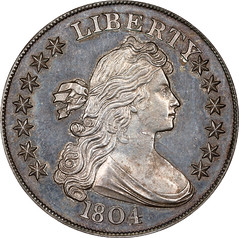 Also, I suspect as Mr. Ward does that Edgar Adams may have gotten the newly announced James A. Stack 1804 dollar. However, I am guessing the dollar also came from Snowden. His partner in crime, Henry R. Linderman, had one and one has to think that A. Loudon would have had one, too! Linderman's wife said that Henry had to make payments for his 1804 dollar! Me thinks the lady doth protest too much!
Also, I suspect as Mr. Ward does that Edgar Adams may have gotten the newly announced James A. Stack 1804 dollar. However, I am guessing the dollar also came from Snowden. His partner in crime, Henry R. Linderman, had one and one has to think that A. Loudon would have had one, too! Linderman's wife said that Henry had to make payments for his 1804 dollar! Me thinks the lady doth protest too much!
The "Hank and Al" show (a Craig Sholley sobriquet) was responsible for most of the irregular issues from the Mint (see Director James P. Kimball's 10 page diatribe in the 1887 Mint Report for elucidation, as he all but names these two).
John sent along this scan of a 1910 reply to a letter sent to Woodin. He notes: As you can see by the letter, it was assumed that Woodin would: "...recover from the parties of whom he had purchased the pattern pieces if they proved to be the Government's property." -Editor
To read the earlier E-Sylum articles, see:
ON THE PROVENANCE OF THE 16TH 1804 DOLLAR
(https://www.coinbooks.org/v28/esylum_v28n35a14.html)
MORE ON THE 16TH 1804 DOLLAR PROVENANCE
(https://www.coinbooks.org/v28/esylum_v28n36a12.html)
Snowden, Lindeman, and Edgar Adams : Snowden, Lindeman, and Edgar Adams
(https://www.coinbooks.org/v28/esylum_v28n37a11.html)
MORE FULBRIGHT SCHOLARS IN NUMISMATICS
Last week, Jeff Burke submitted an article on Fulbright Scholars in the numismatic world. Here are some more. First up is Ken Berger, who submitted these notes. -Editor
 Ken Berger
Ken Berger
I obtained my doctorate in Environmental Science & Engineering from UCLA. A few years later, I returned to school and obtained a second master's degree; this time in Asian Studies. Upon completion of this degree, I was immediately awarded a Fulbright Fellowship in 1989-90 at Tunghai University in Taichung, Taiwan.
The following year, I was named a Visiting Specialist by Taiwan's National Science Council and for the next three years a Visiting Professor by Tunghai University. Besides my teaching duties, I also performed research on feng shui as a natural science and the impacts of oil spills in the South China Sea.
While overseas I gave a seminar at the University of San Carlos in Cebu, Philippines. Attending this seminar was Prof. Humaida Jumalon, the daughter of Prof. Julian Jumalon. After the seminar, I mentioned to her my interest in WW2 Philippine emergency & guerrilla paper money. She told me that her father had designed many of these notes for various provinces during the war. This led to a number of visits with her father during the five years I was living overseas. The initial result of these meetings was an article in The Numismatist ("Cebu Emergency Notes of World War II", The Numismatist (May 1993), Vol. 106, No. 5: 643-648). This was the first major study of the Cebu notes and, more importantly, was the first time Prof. J. Jumalon's involvement became well-known throughout the numismatic community.
Subsequent to this article, I published three books on various Philippine notes. Two of these books were the result of an Author's Grant from the Central States Numismatic Society which enabled me to travel to the Philippines years later to do an in depth study of approximately 200,000 notes that were held by Museo Sugbo (Cebu Provincial Museum). Both of these books were awarded a Literary Achievement Award (Honorable Mention) by IBNS. In 2022, I was awarded a Leadership Appreciation Award by the Philippine Collectors' Forum (PCF) for my contributions to Philippine numismatics. Last year, I was a co-author with Dr. Matthias Voigt and Neil Shafer on a comprehensive catalog of all Philippine emergency/ guerrilla notes that were issued during the war. This catalog was the first update of Shafer's classic 1974 book about these notes.
Norman D. Nicol, Ph.D.
 I was trained in Arabic at the Defense Language Institute, Monterey CA as a young Air Force recruit during most of the calendar year of 1965. I was later stationed in Athens, Greece during the 1967 Arab-Israeli War. Because of that experience and my language training, I developed an interest in Middle East History. I undertook my university studies with that field as my main area of study. While a graduate student at the University of Washington (Seattle), I applied for and was granted a Fulbright-Hays Dissertation Research Abroad Scholarship for 12 months in 1977 - 1978. I long held an interest in coins and so had combined that with my academic studies as I traveled under the Fulbright to a number of countries to study both medieval Islamic coins and Arabic manuscripts, gathering coin data and textual materials for my chosen thesis topic.
I was trained in Arabic at the Defense Language Institute, Monterey CA as a young Air Force recruit during most of the calendar year of 1965. I was later stationed in Athens, Greece during the 1967 Arab-Israeli War. Because of that experience and my language training, I developed an interest in Middle East History. I undertook my university studies with that field as my main area of study. While a graduate student at the University of Washington (Seattle), I applied for and was granted a Fulbright-Hays Dissertation Research Abroad Scholarship for 12 months in 1977 - 1978. I long held an interest in coins and so had combined that with my academic studies as I traveled under the Fulbright to a number of countries to study both medieval Islamic coins and Arabic manuscripts, gathering coin data and textual materials for my chosen thesis topic.
During the year of travel I carried out research at the British Museum and British Library (London), the Ashmolean Museum and Bodleian Library (Oxford), the Bibliotheque Nationale (Paris), the Archaeological Museum and Süleymaniye Library (Istanbul), the National Library and Museum of Islamic Art (Cairo). Upon returning to Seattle, I spent the next year writing my dissertation and received the doctorate in 1979. I returned to Cairo the following year under a Smithsonian post-doctoral grant and wrote a catalog of the coins and related items in the Egyptian National Library, published in 1982.
Since then I have published a number of other books, journal articles and book reviews dealing with numismatic subjects, including four volumes of the catalog of Islamic coins in the Ashmolean Museum while under a 12-year visiting fellowship at Oxford. My other numismatic interest was in German coins. For a number of years I did consulting work and writing for Krause Publications in Iola, Wisconsin, mainly helping to edit their series of standard catalogs of world coins. I also authored three editions of Krause's Standard Catalog of German Coins.
Having been a Fulbright scholar helped to direct my career in serious numismatic research and writing.
As I was returning to the U.S. from Egypt in 1981, I was contacted by Steve Album in Santa Rosa CA and offered a position assisting him in his growing business of dealing in Islamic and Indian coins. I moved to Santa Rosa in May of that year and although my background was mainly in academic numismatics, Steve taught me much about dealing in coins. I worked full time as his consultant for the next eighteen years. During that time, I mainly prepared coins for his retail trade stock and assisted him at coins shows mainly in California, but also at large annual shows such as the New York International, the Chicago show and also shows in London, Zürich, Munich, among others. Steve also encouraged me to continue my scholarly studies of Islamic coins resulting in a number of journal articles and several monographs.
In 1999, I moved back to my home area of Northeastern Pennsylvania to help care for my elderly parents. By that time I had been deeply immersed in genealogy and started a professional genealogical business. I continued to maintain a connection with Steve, who sent me quantities of coins to process for him and enter them online into his stock database. I also helped him with coin shows, mainly those in New York City and Baltimore. By about 2014 or so, Steve's business had grown to include two business partners and was now incorporated as Stephen Album Rare Coins (SARC). He now had a staff of about ten people and no longer required my input, which was fine with me as I was about to retire in any case. Steve and I still stay in contact and sometimes have long phone chats. All in all, my time working with Steve over the years has been nothing but rewarding.
Thanks, everyone. The photo of Norman D. Nicol was taken while he was giving a paper in the Vatican Library September 24, 2011 while attending the 3rd Simone Assemani Symposium on Islamic Coins.
NOTE: Jeff is also aware of Fulbright Scholars Donald Erlenkotter and John Photinopolous, suggested by Pete Smith. He was familiar with them but could only find limited information and decided not to include them in his piece. -Editor
Jeff adds:
"No doubt more names will surface as well. For example, I identified a numismatic scholar who was awarded a Fulbright to the University of Florida for 2025-2026. However, I couldn't find this person in the UF faculty profiles, so I decided not to include him. Some of the most recent Fulbright Awards for stateside and overseas locations seem to have been cancelled. The whole scenario is a little unclear.
"For my article, I focused on past Fulbrighters who were also distinguished numismatists. Then I included a few more recent Fulbrighters who are still alive. A key point for both categories was that I wanted to have enough information about each individual in order to come up with reasonable profiles."
To read the earlier E-Sylum article, see:
FULBRIGHT SCHOLARS IN NUMISMATICS
(https://www.coinbooks.org/v28/esylum_v28n37a15.html)
NOTES FROM E-SYLUM READERS: SEPTEMBER 21, 2025
The Death of Sarah Elizabeth Freeman
Scott Miller writes:
 "Regarding Pete Smith's mention of numismatic writers who were murdered, I would add Sarah Elizabeth Freeman, who wrote Medals Relating to Medicine and Allied Sciences in the Numismatic Collection of the Johns Hopkins University, published in 1964. She died of starvation after being locked in a closet by burglars. The news article can be found here
https://www.upi.com/Archives/1986/03/23/Three-men-charged-in-curators-starvation-death/2185511938000/
"Regarding Pete Smith's mention of numismatic writers who were murdered, I would add Sarah Elizabeth Freeman, who wrote Medals Relating to Medicine and Allied Sciences in the Numismatic Collection of the Johns Hopkins University, published in 1964. She died of starvation after being locked in a closet by burglars. The news article can be found here
https://www.upi.com/Archives/1986/03/23/Three-men-charged-in-curators-starvation-death/2185511938000/
"This is the link to her papers at Johns Hopkins Libraries, which notes her work on coins and medals, incuding research on Charles Cushing Wright. https://aspace.library.jhu.edu/repositories/5/resources/1205"
So sad. Thank you. -Editor
To read the earlier E-Sylum article, see:
GEORGE FREDERICK GOULD (1912-1991)
(https://www.coinbooks.org/v28/esylum_v28n37a14.html)
On the Fractional Currency Fruitcake Box
John Ostendorf writes:
"Regarding the fractional currency bricks - that's the first good thing to come out of a fruitcake box!"
To read the earlier E-Sylum article, see:
ORIGINAL FRACTIONAL CURRENCY BRICKS
(https://www.coinbooks.org/v28/esylum_v28n37a17.html)
The Finest Known 1853-O No Arrows Half Dollar
Saul Teichman writes:
"The Eliasberg coin is not the finest of the 1853-o no arrows half dollar. The finest was the Garrett coin.
"All 4 known examples are imaged by me on the Newman portal at the link below. https://nnp.wustl.edu/library/book/648390"
Thank you. -Editor
To read the earlier E-Sylum article, see:
1853-O NO ARROWS HALF DOLLAR AUTHENTICATION
(https://www.coinbooks.org/v28/esylum_v28n37a07.html)
Carson City Trade Dollar Varieties
Brian Koller writes:
I have studied auction appearances of Carson City Trade dollars in Heritage and Stack's Bowers auction lots, and created tables of die varieties, one table each for the 1873-CC through 1878-CC.
 When I began this effort some three years ago, I didn't realize that I was duplicating the efforts of
Joe Kirchgessner
and
John B. Coxe,
who have already published references on die varieties of the Trade dollar series. Nonetheless, I have encountered a number of die marriages not in those references, and I hope the tables will be of use to researchers and specialists.
When I began this effort some three years ago, I didn't realize that I was duplicating the efforts of
Joe Kirchgessner
and
John B. Coxe,
who have already published references on die varieties of the Trade dollar series. Nonetheless, I have encountered a number of die marriages not in those references, and I hope the tables will be of use to researchers and specialists.
The tables can be found at https://filmsgraded.com/cctrade. The first column in the tables is a link to an auction lot for each die variety. The tables map each variety to its Kirchgessner and Coxe counterparts. The HA prefix is an abbreviation for Heritage Auctions. Please report any corrections, additions, improvements, etc. to briankoller@yahoo.com.
Thank you. -Editor
VOCABULARY TERM: ROLLER DIE
Here's another entry from Dick Johnson's Encyclopedia of Coin and Medal Terminology. -Editor
Roller Die. (1) A die engraved on the curved surface of a cylinder which is rolled over metal strip under pressure impressing a coin design on the sheet metal, which is blanked afterwards. First created in 1551, in Augsburg, Germany, by Kaspar Goebels, the process spread to other parts of Europe with very mixed results. The process was called taschenwerke and the roller mill was termed the walzenwerke. A larger coin could be made by this method in contrast to stamping a blank in a press. It's shortcomings, however, was the edges of the coin after it was trimmed or blanked from the strip, it had striations on the edge and burrs on one side. These had to be smoothed by hand.
A mint technician, Nicholas Briot (1580-1646), tried to introduce this process first at the Paris Mint (1637), then at the Royal Mint London and was rejected at both mints. After he was accepted as mintmaster at the Edinburgh Mint in Scotland he introduced the roller die process and produced coins there but the process was shortlived. The process was tried for an issue of tokens by Lord John Harrington of Exton. He was issued a patent of James I in May 1613 to manufacture tokens (numismatists call these "Harrington farthings"). The process would place the image on strips of metal and blank individual pieces afterwards; some of the strips still survive. What makes this interesting for collectors is that the Duke of Lennox issued the same design farthings in diestruck pieces. The same process was tried to be reintroduced with 20th century technology by General Motors. An experimental press and extensive tooling was created, but in all testing it proved unsuccessful. In practice the process heated up the dies which failed.
To read the complete entry on the Newman Numismatic Portal, see:
Roller Die
(https://nnp.wustl.edu/library/dictionarydetail/517316)
MICHAEL S. MACDOUGALL (1902-1996)
E-Sylum Feature Writer and American Numismatic Biographies author Pete Smith submitted this article on "Card Detective" and coin columnist Mickey MacDougall. Thanks! -Editor
 Want to flush out a crooked dealer at the card tables? Call on Mickey MacDougall, "The Card
Detective." Want to expose a tall tale in numismatics? Perhaps MacDougall can help with that.
Want to flush out a crooked dealer at the card tables? Call on Mickey MacDougall, "The Card
Detective." Want to expose a tall tale in numismatics? Perhaps MacDougall can help with that.
Michael MacDougall was born as Samuel Smiley MacDougall on October 22, 1902, in Philadelphia, Pennsylvania. His father was a grocer, William J. MacDougall (1870-1955). His mother was Margaret Jane "Janny" Belford (1870-1953). Both of his parents were from Irish emigrant families.
Slight in stature at age 14, he landed a job with Horace Goldin in vaudeville as the boy on the rope in an Indian rope trick. He studied magic and learned card tricks. He visited gambling parlors and watched the action. MacDougall made friends with some of the dealers. He taught them card tricks and they taught him gambling tricks. By age 18, he was one of the best card manipulators in the business.
A banker had been losing money at his club while another member was winning too often. The banker invited MacDougall to watch the action. He uncovered the secret and demonstrated to the club how they were being cheated. When he got a thousand-dollar gift of thanks, he decided to go into business and became known internationally as "The Card Detective." He was the best in the business, or perhaps, the only card detective in the business.
He wrote several books on card tricks and gambling and was a frequent speaker to civic groups. He claimed that 95% of gambling institutions were crooked. The exception was Las Vegas where gambling had been cleaned up and 95% of the business was honest. MacDougall served on the Nevada State Gaming Board.
During World War II, he worked with naval intelligence to expose crooked dealers and card sharks who preyed on servicemen.
He wrote a column for the weekly Sunday edition of The Newark Star-Ledger. "The Inside Straight" ran from July 18, 1948, to December 30, 1962. At the peak, he was syndicated in 103 newspapers.
I wrote an article for The Asylum on "An Incomplete Listing of Coin Columnists." I did not include MacDougall because his column was about gambling. At one time he claimed to have a stamp collection worth $30,000. Some of his columns were about fraud in philately. He also told stories from his experiences at coin shows.
He lived in New York City from 1954 to 1963, and was a member of the Brooklyn Coin Club. The Numismatist reported on exhibits of his collection at club meetings. In 1954 he exhibited a gold type set; in 1955, twenty crown size foreign gold coins and a Canadian Sovereign; in 1956, a set of Canadian devil bank notes; later in 1956, a set of world crowns beginning with the letter ‘S'; in 1957, gold coins from Albania, Bulgaria, Hungary and Romania; again in 1957, gold coins of Iran and Italy.
At the 1962 Penn-Ohio show, he entertained after dinner with his "Card Detective" act.
He was ANA member 22263, living at 7735-113th Street in Forest Hills, New York, in 1959. He was still living in Forrest Hills, Queens, in 1980.
He was world famous as "The Card Detective" but he was scarcely noticed as a coin dealer. There are a few reports that he had a table at coin shows during 1960-1980.
MacDougall died on St. Patrick's Day, March 17, 1996, in Hollywood, Florida. He is buried with his parents at Greenmount Cemetery in Philadelphia.
Several of MacDougall's columns were about coins.
For March 2, 1952, he wrote "Remember hoax of the 50-cent Ford cars?" There was a rumor that the letter on the back of 1909 dimes could spell F-O-R-D-S and a set of five could be traded in for a new Ford car. Unfortunately, only the letters O-D-S were actually on the dimes.
The column for July 5, 1953, was about "Spurious Doubloons Are Passed Off As Real Thing." This was about silver Maria Theresa Thalers that were gold plated and passed as gold coins.
A column published on December 12, 1954, was about the legality of owning gold coins. Yes, they could be owned but could not be spent.
An article published on March 1, 1959, was about "The Lincoln Cent Scheme." It was about a dealer selling coin holders for fifty Lincoln Cents and offering to buy the completed set for $35. MacDougall said a collector would need to look through ten million cents to fill the folder.
His column for May 17, 1959, was about "Copper 1943 Pennies Valuable."
The column for October 25, 1959, was titled, "Check Your Pennies." It was about Hannah O'Brien, who found a bunch of 1955 double die cents in Boston.
An article on July 31, 1960, was titled, "Lowly penny launches a new treasure hunt." It was about the 1960 small date varieties.
Some of his columns were printed under a sub-heading, "True Stories That Couldn't Happen—But Did." One of them was of particular interest. The title of this May 1, 1955, story was "Deaf Mute's Gyp Game Caused Change In Coin Design." The story appeared in other papers with different titles on different dates.
MacDougall told the now familiar story of Joshua Tatum who had 1883 Nickels gold plated to pass as $5 gold coins. I have been trying for thirty years to find the source of this story and others have tried as well. No other source has been found that predates May 1, 1955.
MacDougall was known to expose frauds in gambling. However, he told the Tatum story as if it were totally true. I suspect he made up much of the story.
I have read many of MacDougall's columns and see a pattern. He begins with a personal name and then tells their story. It may be about a rare coin, a counterfeit coin or a coin swindle. The numismatic part of the story is believable. However, it cannot be confirmed as relating to the name mentioned.
In 1883, there were stories of people charged with passing the new nickels as gold coins. That part of the story is well known. The name of Josh Tatum does not show up until 1955. I believe MacDougall may have added some Irish blarney and made that up. It remains speculation based on the best information available.
VISITING DANSCO'S MANUFACTURING PLANT
Justin Hinh, aka Dansco Dude, recently visited the Dansco manufacturing plant and submitted this report. Thank you! -Editor
In March and August of this year, I had the incredible opportunity to visit the Dansco manufacturing plant in Sumas, Washington. During my two visits, the husband-and-wife team of Steve and Leticia Bruce graciously welcomed me into their facility and answered many questions from collectors.
Walking through their factory floor revealed a treasure trove of numismatic history. As a researcher dedicated to the history of both Dansco and the broader world of coin albums, it was an unforgettable experience.
The Dansco family has asked me to maintain the privacy of their internal operations, so I am not able to share pictures of the production process. However, I can share this humorous photo I took right outside their entrance.
Unraveling Dansco's History
Piecing together Dansco's early days is a fascinating puzzle. The company has a rich family legacy, starting with co-founders Paul Bruce and a partner named Daniel in 1937. The history of who Daniel was is part of my ongoing research. Paul's son, John Bruce, took over operations in 1959, and the third generation, Steve Bruce, took the helm in the 1990s. Beyond the family, I was able to confirm several other historical details:
- Hobbies Unlimited: Dansco also produced coin folders for a company called "Hobbies Unlimited" in the early 1950s, with some examples bearing a 1952 Dansco copyright.
- Competitors Next Door: During their time in Los Angeles, Dansco's office was located just up the street from another album manufacturer, Meghrig.
- Early Partnerships: Before Littleton produced their own albums, they partnered with Dansco in the 1980s. You can often identify these Littleton versions by the front, where it reads "Littleton's Prestige Collectors Series."
- Leticia shared a remarkable historical photo showing some of the first Dansco employees, including co-founder Paul Bruce.
Design, Philosophy & Operations
Collectors often notice minor changes to folders and albums over the years. I got to ask about the logic behind some of these details and their business philosophy.
- P-S-D vs. P-D-S: Early folders listed mints in the order of Philadelphia, San Francisco, and Denver. This was later changed to the now-standard Philadelphia, Denver, and San Francisco to better align with the official Red Book.
- Title Format Changes: The fonts and styles on albums sometimes change between print runs. This is simply an aesthetic choice to give the album a fresh look. There is no formal process for when and how styles change.
- Slipcase Origins: The iconic Dansco slipcases were first introduced around 2003-2004.
- Official Website: There are no plans to revamp Dansco's official website (danscousa.com). The family is happy with its current state as an informational hub for the community. On a related note, they confirmed they do not run the "Dansco Album Store" website and are unsure who operates it.
- Focus on Product, Not Competitors: The family doesn't focus too much on competitors like Whitman. They prefer to run a small, tight-knit operation, concentrating on what they do best: creating high-quality albums that collectors love. It's a remarkably small company, with only about eight employees, four of whom are from the Bruce family.
- Commitment to the Classic Design: This focus also answers a common question about slabbed coins. The family explained that their production process is geared toward the classic, thin-page design for raw coins. The logistics of a thick, binder-style album for slabs don't fit their operational model. So while collectors often ask, there are no plans to produce albums for slabbed coins.
- A Unique Location: The manufacturing plant is right next to the Canadian border. In fact, you can see the border crossing right outside their factory.
Niche Products & Lost Histories
Beyond their main U.S. coin series, Dansco has a history of unique and surprising projects.
- Special Edition Albums: Over the years, Dansco has produced albums for the UN Food and Agriculture Organization (FAO), the Franklin Mint, and even Marvel Comics. Most collectors aren't aware that Dansco produced these niche albums.
After the Flood
The family is still dealing with the ramifications of the major flood that hit Sumas in late 2021. The flood devastated the entire production floor, and I could still see the water stains on the walls. For a moment, the family feared that the company wouldn't be able to weather the storm. It's a testament to their resilience that they are back up and running, although they are still operating below their maximum production capacity.
The Future of Dansco
Perhaps the most exciting part of my visits was getting a sneak peek at what's coming next. Here's what collectors can look forward to:
- The Gold Type Page: The long-awaited update for the #7070 U.S. Type Set Gold Page is planned for another print run next year.
- Libertad Album Update: A new printing of the Mexico Libertad album is planned, featuring an updated page that extends to 2029. This will hopefully be available late this year or early in 2026.
- New Slipcases: They are currently producing new 3/4" slipcases.
- Future Series: They are not hearing much demand from collectors for Canadian albums at this time. As for the 2026 Semiquincentennial, there are no current plans, as they are waiting for the U.S. Mint to finalize the designs and coin releases.
A Call for Community Feedback!
Best of all, Dansco is actively exploring the potential for a Volume 2 of the #7070 U.S. Type Set album. They are inviting collectors to share what coins and series they would like to see included.
This is a fantastic opportunity for us to have a direct impact on the next version of the #7070 U.S. Type Set album. If you have ideas, please send them directly to Dansco at danscocorp@aol.com.
The Ongoing Search
This report covers everything I can share for now, but the research continues! There are still many outstanding questions to answer, such as the logic behind early folder color choices and who Daniel in Daniel Stamp Company was. I am continuing to work with the family to find these answers. Hopefully, a third visit is in store for the future.
ATLAS NUMISMATICS SELECTIONS: SEPTEMBER 21, 2025
Atlas Numismatics has updated their website with 346 new coins, medals, and tokens at fixed prices. Select items are discussed below. -Garrett
1083817 | AUSTRIA. Leopold V. (Archduke, 1586-1632). (1626) AR 2 Thaler. PCGS MS62+. Hall (Tyrol). LEOPOLDVS • ARCHID • AVS • ET • CLAVDIA • ARCHIDVCISA • AVS • MEDIC. Conjoined busts of Leopold and Claudia, right / DVX • BVRGVNDIAE • COMES • TIROLIS:. Crowned eagle within inner circle, legend around. KM 639 (KM 808); Dav.-3331. For the wedding of Leopold V and Claudia de Medici in 1626.
$4,950
To read the complete item description, see:
Wedding of Leopold V and Claudia de Medici
(https://atlasnumismatics.com/1083817/)
1083477 | AUSTRIA. Joseph I. 1706 IAK AR Thaler. PCGS MS67. Hall. 43mm. IOSEPHUS · D: G: ROM: IMP: SE: AV: G: HV: BO: REX ·. Laureate armored bust right /ARCHID: AVST: DVX: BV: COM: TYR ·. Arms within Order chain. KM 1438.1; Dav.-1018; Herinek 132.
$27,950
To read the complete item description, see:
Superlative Joseph I Thaler
(https://atlasnumismatics.com/1083477/)
1083468 | GERMAN STATES. Bavaria. Otto. 1911-D AR 3 Mark. PCGS PR66. Munich. Edge: GOTT MIT UNS. Head right / Crowned imperial eagle, shield on breast. KM 998; Jaeger 49; AKS-206. 90th Birthday of Prince Regent Luitpold. Superbly toned.
$1,695
To read the complete item description, see:
Colorful Bavaria Proof
(https://atlasnumismatics.com/1083468/)
1084110 | GREAT BRITAIN. George II. (King, 1727-1760). 1729 AV Five Guineas. NGC AU58. London mint. Edge: TERTIO. GEORGIVS · II · - DEI · GRATIA ·. E.I.C. below head /F · D · B · ET · L · D · S · R · I · A · T · ET · E · - M · B · F · ET · H · REX ·. Crowned 4-fold arms. KM 571.2; SCBC-3664; Fr.-333. Highly lustrous and very appealing.
$49,500
To read the complete item description, see:
East India Company Five Guineas
(https://atlasnumismatics.com/1084110/)
1082913 | SIERRA LEONE. 1791 AR Dollar. NGC MS61. Soho (Birmingham) mint. 35mm. 25.85gm. SIERRA LEONE COMPANY. Lion, Africa below / Clasped hands flanked by value, date below, written value as legend. KM 6; Vice 2A. Dated 1791, though struck in 1793 at Matthew Bolton's Soho (Birmingham) mint.
$8,950
To read the complete item description, see:
Mint State Sierra Leone Dollar
(https://atlasnumismatics.com/1082913/)
Updates to their online inventory are issued monthly.
For more information and to sign up for the firm's monthly newsletter, visit:
atlasnumismatics.com.
NUMISMAGRAM MEDAL SELECTIONS: SEPTEMBER 21, 2025
Numismagram's Jeremy Bostwick sent along these four medals from his most recent upload of new material to his site. For all of the new items, please visit https://www.numismagram.com/inventory. -Editor
103246 | GERMANY. Bayern (Bavaria). Agricultural Association silver Award Medal. Issued circa 1901-1913 for loyalty and diligence (47mm, 49.28 g, 12h). By Alois Börsch. DER LANDWIRTHSCHAFTLICHE VEREIN IN BAYERN, plow right // LOHN / DER TREUE / UND DES / FLEISSES in four lines within garlanded oak wreath. Edge: Plain. Hauser 668. PCGS MS-62. Extremely lustrous and prooflike, with sparkling, iridescent toning across both sides. $365.
To read the complete item description, see:
103246 | GERMANY. Bayern. Agricultural Association silver Award Medal.
(https://www.numismagram.com/product-page/103246)
103302 | GREAT BRITAIN & GERMANY. William Shakespeare uniface bronze Plaque. Issued 1911. Famous Men series (39mm x 50mm, 20.23 g). By Mayer & Wilhelm in Stuttgart. Bust facing slightly left in central medallion; two lighted tripods to either side in background; on base below, central panel reading SHAKESPEARE / 1564 1616, and with cloaked figure kneeling facing, head left, holding dagger and tragedy mask; palm frond and laurel branch to left // Blank. Edge: Plain. Bernd Kaiser V, 548; Serie berühmter Männer 93; Heidemann –. Choice Mint State. Tan-brown surfaces. $225.
To read the complete item description, see:
103302 | GREAT BRITAIN & GERMANY. William Shakespeare uniface bronze Plaque.
(https://www.numismagram.com/product-page/103302)
103172 | BULGARIA & GERMANY. Ferdinand I silver Medal. Issued 1915. The alliance of Bulgaria with Germany and Austria-Hungary (33mm, 18.33 g, 12h). By August Hummel at the Ludwig Christian Lauer mint in Nürnberg. FERDINAND I. KÖNIG VON BULGARIEN, bust left // UNSERE SACHE IST GERECHT v. HEILIG.=VORWÄRTS!, right hand facing upward, with two fingers making sign of benediction; sword hilt and 1915 to left, crowned coat-of-arms to right, thunderbolt below. Edge: SILBER 990. PCGS SP-64. Exceedingly vibrant and prooflike, with deep toning offering great color across both sides. Compare to a similarly colored example, a PCGS SP-65, that realized a total of $900 in the Stack's Bowers Global Showcase Auction (5 September 2025), lot 46082. $695.
The Quadruple Alliance of WWI emanated from the alliance of Germany and Austria-Hungary in 1879. The Ottoman Empire (in November 1914) and the Kingdom of Bulgaria (in October 1915) joined after the outbreak of the war, though the former had maintained a close relationship with both Germany and Austria-Hungary for a number of years. Economics were the main facet for an Ottoman entry, as Germany played an important role in the empire's financial growth and success, while reclamation was the major goal of Bulgaria, as she wished to win back territory ceded to Serbia during their losses in the Balkan Wars of 1912-1913.
To read the complete item description, see:
103172 | BULGARIA & GERMANY. Ferdinand I silver Medal.
(https://www.numismagram.com/product-page/103172)
103266 | ITALY. St. Benedict of Nursia bronze Medal. Issued 1980 for the 1,500th anniversary of the birth of one of the patron saints of Europe (61mm, 179.04 g, 12h). By Angelo Grilli for the Colombo mint in Milano. Facing head, with right hand uplifted and "PAX" in stylized letters floating above; S B?N?D?TTO 480 1980 // Cloaked figure of St. Benedict standing right, holding outline of Europe in his hands. Edge: Plain. As Made. Light brown-bronze surfaces, with tremendous relief upon the obverse. A powerful piece of contemporary art. $195.
Born in the late 5th century CE in Nurcia, Benedict founded numerous monastic communities in modern-day Lazio. He also established a number of rules for monks to follow, now known as the "Rule of Saint Benedict," with them heavily influencing Christian monasticism in the West. He was canonized in the early 13th century by Pope Honorius III and, in 1964, was declared a patron saint of Europe by Pope Paulus VI.
To read the complete item description, see:
103266 | ITALY. St. Benedict of Nursia bronze Medal.
(https://www.numismagram.com/product-page/103266)
SOVEREIGN RARITIES AUCTION XIX SELECTIONS
Sovereign Rarities will hold their Auction XIX on Tuesday September 23rd. Here is a final group of selections. Great coins. -Editor
Sovereign Rarities proudly present their 19th Auction to be held at their London office on Tuesday 23rd September in conjunction with the Royal Mint. The online catalogue is now available to view at www.sovr.co.uk with images and estimates of every lot, as well as being hosted on a number of other auction platforms with highlights on social media too. This is the final instalment of highlights for The E-Sylum before sale day on Tuesday starting 10am UK time.
The sale commences with the magnificent Thorburn Collection of coins of 1887 mostly struck for the Golden Jubilee of Queen Victoria, consisting of a plethora of as many UK currency coins, patterns and proofs of the celebration as possible, collected over 30 years. The sale now has its own pdf flipbook with all relevant introductory passages at this link SOVR Auction XIX - Featuring the Thorburn Collection - Flip Book Catalogue
One of the rarest currency gold coins in the sale is the 1887 Two Pounds with the obverse usually seen with the proof version of this coin. Lot 13 has an obverse with the B of BRITT much closer to the crown of Victoria than the more regular currency pieces and is thought to have been issued only on a very small day of mintage (a journey) of 350 pieces recorded on the 8th August 1887.
The collection as mentioned previously contains many of the rare "hooked J" variations of the Jubilee currency Sovereigns and Half-Sovereigns whether minted in London, Sydney or Melbourne. All of the variations were published in the pioneering work by David Iverson and edited by Steve Hill hence the acronym DISH for the reference of each. The London Sovereigns (lots 19-22) consist of four of the five known variations, whereas the Sydney and Melbourne mints have a full house of all the known variations of hooked J, five for Syndey (lots 31-35) and four for Melbourne (lots 39-42). The gold Half-Sovereigns with "hooked J" for London (lots 47-51) run to five out of the six known variations, Sydney Mint (lots 61-66) has all five of the known variations and Melbourne Mint (lots 68-72) has five of the six known variations. Lot 51 the hooked J DISH L506 is the actual coin that was illustrated in the plate of the DISH publication. All of these early hooked J gold coins represent the designs used for initial issues of their denominations all having the J.E.B. initials for Joseph Edgar Boehm hand-stamped with punches onto each die. David Iverson's eureka moment in this research was when he discovered the mint ledger in the public record office at Kew, London that mentioned that only six obverse dies were supplied each to Melbourne and Sydney for the new Jubilee Sovereigns and in turn for the Half-Sovereigns. This is also thought to be the case for the London mint too which has been borne out so far for the last ten years by the surviving population of coins examined. The ledger even revealed that the J.E.B. initials were stamped onto the dies by mint employee William Poplett who must have had incredibly good eyesight, with the hand stamped nature meaning the positioning of each variation is different to one another. This has become a fascinating series to collect and finally solved the issue of what was previously listed as "spread" or "close" initials in the general publications.
The sale continues through the silver currency which we highlighted last week and through the pattern issues of Spink and Rochelle Thomas for the Crowns of which there are six different metals present as well as nineteen pattern sixpences including three gold which are all different in one way or another. We illustrated the finest one previously, but this week we feature the variation with "MADE IN BAVARIA" stamped on the edge in reference to the manufacturer L. C. Lauer. There were purportedly seven examples struck in gold but this is thought to refer to a total for the plain edge and the Made in Bavaria edge together with the latter being the rarer. This fascinating series of patterns was made in at least six different metals, with three different edges. The design can differ with having the Spink name present on the reverse or not, plain truncation on the Queen or with S&S or JRT added. The array of pattern Sixpences is thought to cover all the possible permutations available to own which is we believe the first time an auction has offered all in one place.
Turning to the general part of the sale, the Anglo-Saxon contains a number of rare and interesting pennies whether by design of mint. One of the more interesting pieces is the Eadgar portrait Penny above, minted in the City of London with a crowned bust right and a reverse that features four extra small crosses than usually seen in the field around the larger central cross in cruciform arrangement. This appears to be the only one available for a collector to purchase at the current time being unique.
We hope that collectors from around the world will join with us live online Tuesday 23rd September from 10am GMT www.sovr.co.uk
To read the earlier E-Sylum articles, see:
1935 GEORGE V SILVER JUBILEE CROWN IN GOLD
(https://www.coinbooks.org/v28/esylum_v28n35a16.html)
SOVEREIGN RARITIES AUCTION XIX
(https://www.coinbooks.org/v28/esylum_v28n36a20.html)
SOVEREIGN RARITIES AUCTION XIX: THORBURN COLLECTION
(https://www.coinbooks.org/v28/esylum_v28n37a20.html)
HOLABIRD SEPTEMBER 2025 SALE: NUMISMATICS
Here's a selection of numismatic lots that caught my eye in the September 2025 Holabird Americana sale. -Editor
Lot 3000: Series 1935 A, signed by Julian & Morgenthau. Stamped Hawaii twice on the front and across the back. Crisp uncirculated, except one corner was folded at one time. The purpose of these notes was should there have been an Imperial Japanese invasion of the islands, the US government could immediately declare any Hawaii-printed notes worthless, due to their easy identification. Beginning on August 15, 1942, no other paper U.S. currency could be used except under special permission.
To read the complete lot description, see:
Hawaii $1 Silver Certificate [200448]
(https://holabirdamericana.liveauctiongroup.com/Hawaii-1-Silver-Certificate-200448_i57846341)
Lot 3016: Series 1935A Africa note. Serial number R92066682C. Gold seal one dollar silver certificate. Signed Egypt Aug 1944. F-EF condition. Printed for use during Operation Torch, the Allied invasion of North Africa. It bears the usual 1935A Julian-Morgenthau signatures. However, this note bears a yellow Treasury seal instead of blue, to assure instant recognition (and devaluation) in the event of defeats by the enemy, or enemy capture of large quantities of cash.
To read the complete lot description, see:
North Africa Silver Certificate [200447]
(https://holabirdamericana.liveauctiongroup.com/North-Africa-Silver-Certificate-200447_i57846357)
Lot 3039: Two unusual World's Fair Exposition tokens: 1) 1933 Chicago A Century of Progress, good luck token; 31 mm. 2) 1939 New York World's Fair The Hall of Nations; 20 mm.
To read the complete lot description, see:
World's Fair Tokens: Chicago & New York (2) [202636]
(https://holabirdamericana.liveauctiongroup.com/World-s-Fair-Tokens-Chicago-New-York-2-202636_i57846380)
Lot 3458: Engraved sports medal to T. H. Picknell 1914-15 from the Cal. Football Ass'n. 19.5 grams; 34 mm.
To read the complete lot description, see:
Cal Football Association Silver Medal 1914 [198287]
(https://holabirdamericana.liveauctiongroup.com/Cal-Football-Association-Silver-Medal-1914-198287_i57846799)
Lot 3465: Great Fight! Heart shaped medal commemorating the Corbett/Fitzsimmons boxing match March 17, 1897 at Carson City Nevada. 27 x 31 mm. Nevada's first legal prize fight, held on St. Patrick's Day was also the first full length film. The crowd mostly supported "Gentleman Jim" Corbett, the former title-holder. He appeared to be the victor in the early rounds, marking Fitzsimmons face with several cuts. In the sixth round, Corbett landed an uppercut to Fitzsimmons' jaw, followed by a right hand to his nose, causing him to stagger, but he stayed upright and Corbett began to tire in the next round. The two traded blows during the next seven rounds, with the fatigued Corbett having little power behind his punches, and Fitzsimmons waiting for the right opportunity to strike. It came in the 14th round, when Corbett raised his gloves to protect his face, after being hit on the neck, and Fitzsimmons followed with a strong punch to Corbett's body, just under his heart; the blow caused Corbett to crumple into the ropes and let out a loud moan. Fitzsimmons landed a second punch to Corbett's stomach and the former champ fell to his knees. He couldn't rise to his feet and the referee counted him out.
To read the complete lot description, see:
Fitzsimmons/Corbett Boxing Medal [202341]
(https://holabirdamericana.liveauctiongroup.com/Fitzsimmons-Corbett-Boxing-Medal-202341_i57846806)
Lot 3468: Choice high relief silver medal. Westminster Kennel Club Bench Show // Awarded / To / Oak Ridge / Rosa's / Wohlen / 1914. 49 mm; 50 grams. Oak Ridge Rosa was a female German Shepard belonging to Mr. Thomas F. Ryan. The Westminster Kennel Club Dog Show is the second-oldest continuously held sporting event in America after the Kentucky Derby. The first show in 1877 held in Manhattan at Gilmore's Garden drew more than 1,200 dogs over four days. For the last 100 years its been held at Madison Square Garden.
To read the complete lot description, see:
Westminster Kennel Club Silver Medal 1914 [202349]
(https://holabirdamericana.liveauctiongroup.com/Westminster-Kennel-Club-Silver-Medal-1914-202349_i57846809)
Lot 3506: Bryan Money HK-785
Obv. In nine lines, first curved, others straight, A Government Dollar Contains / 412 1/2 Grains / Coin Silver 900/1000 Fine / This Piece Contains / 823 Grains Coin Silver / In Value the Equivalent of / One Gold Dollar / Sept. 16th 1896. / Spaulding & Co. No rim.
Rev.: On rim of cartwheel, which springs from bottom edge, Size of Government Dollar Containing 412 1/2 Grains of Silver 900/1000 Fine; no rim. Silver. 52mm. Schornstein 16.
To read the complete lot description, see:
Bryan Money HK-785 [182808]
(https://holabirdamericana.liveauctiongroup.com/Bryan-Money-HK-785-182808_i57846847)
GUT-LYNT AUCTION 22 COIN SELECTIONS I
The 22nd Gut-Lynt coin auction will take place on the first weekend in October, starting on the public holiday (German Unity Day) on 3 October 2025. For the first time, more than 5,000 lots will be offered over three auction days. October 4th's selections comprise of coins and medals from antiquity to the present day. We would like to present some of the highlights here. -Garrett
The auction on Saturday, 4 October at 9:00 a.m. (CEST) will begin, as is tradition, with ancient coins. Around 500 lots will be offered, ranging from Celtic coins to Greek and Roman coinages to issues from Byzantium and Islamic rulers. In addition to attractive individual pieces, the many well-described lots with moderate starting prices are particularly noteworthy.

Lot 2109: Aeolis, Cyme, tetradrachm, circa 150-140 BC, stephanophorus type. Minted under the magistrate Metrophanes, excellent, estimate €400

Lot 2191: Roman Republic, C. Julius Caesar, denarius, late 46 BC – early 45 BC, army mint in Hispania, very fine, estimate €200
Following this, from around 11:30 a.m. (CEST), more than 1,000 lots of German coins and medals from the Middle Ages to the 20th century will form the next section. Particularly noteworthy are the special collections ‘ROMERIKE BERGE (Part 1)' from a coin collector in Bergisch, an attractive collection of Brunswick coins, and the ‘ALSTERBLICK' collection from an old Hamburg family estate with coins from the German Empire in exquisite condition.

Lot 2506: Anhalt-Bernburg, silver medal 1693. Commemorating the resumption of mining in Harzgerode, brochure mark, very fine, estimate £170

Lot 2726: Brunswick, city. Silver medal, 1845, commemorating the 300th anniversary of the establishment of the shooting club. Peltzer collection only in bronze, fine hairline scratches, good to excellent condition, estimate €100

Lot 2753: Brunswick-Wolfenbüttel, ½ taler 1608, St. Andreas yield, Müseler specimen, very fine, estimate €150

Lot 2806: Brunswick-Hanover, 2/3 Taler (24 Mariengroschen) 1766, Welter zu 2817 (year missing!), extremely rare, very fine, estimate €400

Lot 2852: Brunswick-Celle, taler, no date (1643/48), fields smoothed, handle mark, very fine, estimate £100

Lot 2939: Johanngeorgenstadt, silver medal 1904. City anniversary, minor scratches, good very fine, estimate €120

Lot 2968: Jülich-Kleve-Berg, taler 1573, rare in this condition, almost excellent, estimate 600 euros

Lot 2997: Jülich-Kleve-Berg, 2/3 taler 1750, yield from the Bergisch mines near Wildberg, fine patina, excellent, estimate 1200 euros

Lot 2999: Jülich-Kleve-Berg, ducat 1751 (changed from 1750), probably the second known specimen, excellent, estimate €7,000

Lot 3044: Lindau, silver medal 1730, Augsburg Confession, fine patina, good to excellent condition, estimate €300

Lot 3081: Munich, oval silver cast medal, 1930. Model workshop, Deutsches Museum. Unique item. Estimate: 250 euros

Lot 3124: Papenburg, silver medal 1860, premium from the "Erste Assecuranz Compagnie", good to excellent, estimate €200

Lot 3169: Saxony, ¼ taler 1652, magnificent specimen, rare in this condition, very fine, estimate €120

Lot 3265: Stolberg-Wernigerode, taler 1760, commemorating his 50th anniversary as ruler, very fine, estimate €1,500

Lot 3266: Ulm, silver medal 1931, commemorating the death of Edmund von Marabini, historian and coin collector, slightly rubbed, very fine, estimate €100
The coin section according to Jaeger from 1871 onwards is particularly impressive due to the excellent quality of the coins in the ‘Alsterblick' collection. It contains an almost complete collection of silver coins from the German Empire, all of which are of consistently high quality.

Lot 3331: Baden, 5 Mark 1891 G, without crossbar in the A of BADEN, extremely rare in this condition, fine mint condition, estimate 7,000 euros

Lot 3394: Hesse, 5 Mark 1875 H, very rare in this condition, slightly touched, proof, estimate 5,000 euros

Lot 3718: First World War medals, cast iron medal, undated (1918), On the separate peace with Russia. Stamp by Dasio, very rare, excellent, estimate €50
The auction day concludes with a small series of rare art medals.

Lot 3780: Italy, bronze cast medal, undated (circa 1489), by Niccolo Fiorentino. 287.76 g. On Nonina Strozzi, later casting, almost excellent, estimate €200

Lot 3783: Italy, bronze cast medal, 1446, by Matteo de Pasti. 38.28 g. Depicting Isotta degli Atti, old, possibly contemporary cast, casting defects and perforated, almost excellent condition, estimate €300

Lot 3782: Germany, Saxony. Silver cast medal, undated (1536), by Hans Reinhart the Elder. 32.38 g. Depicting the Fall of Man and the Crucifixion, original cast with soldered applications, rare, almost excellent condition, estimate €1,000

Lot 3795: Germany, silver cast medal 1526, by Hans Schwarz. 44.39 g. Depicting Louis V, contemporary cast, extremely rare, excellent condition, estimate €1,000
The online catalogue will be available from the beginning of September on the auction platform www.auktionen.gut-lynt.de. Please remember to register in good time if you wish to bid for the first time. We accompany each auction with exclusive highlights on Instagram @muenzen_gut_lynt. Our website www.gut-lynt.de also offers previews and reviews as well as up-to-date information on auction dates and delivery deadlines.
If you have any questions about the auction, we are happy to help: simply write to info@gut-lynt.de or call us on: (+49) 02156 4874819. We look forward to hearing from you.
PS: Gut-Lynt Auction 23 is scheduled for the first weekend of Advent, 29th and 30th November 2025. Just in time for St. Nicholas Day, you can treat yourself to a gift. If you would like to part with individual items or entire collections, please do not hesitate to contact us. We offer consignors favourable terms and our passion.
Note for non-EU customers: Due to customs regulations, it is unfortunately not possible to ship certain lots to non-EU countries.
As DHL has temporarily suspended parcel and goods mail delivery to the USA (as of 31 August 2025), shipments to the USA will be stored by us until parcel delivery is possible again. Alternatively, another shipping method, such as FedEx, can be selected, but at a higher cost.
KUENKER AUCTION SALE 429
A separate catalog presents the second part of the Verschoor Collection. It contains coins from Dutch overseas territories, and is therefore all about the VOC, the Dutch East India Company. Its logo with the three well-known letters can be seen on many issues. Other silver coins that were created for long-distance trade in the Netherlands depict the so-called silver rider. It was so well-known that it was used as a countermark for Indish coins that were to be used for financial transactions in Batavia. -Garrett
A 1/4 gulden from Utrecht, produced for the Dutch East Indies in 1900, is extremely rare. Only five specimens of this type were minted.
Those attending the auction in person will also have the opportunity to view the material of auction 430, featuring part 4 of the Lodewijk S. Beuth Collection, this time containing Dutch banknotes. This important auction will be held as an eLive Premium Auction on 20 October.


No. 2598: Issues of the Province of Utrecht. Off-metal strike in gold from the dies of the Ku.-1/2 duit, 1758, Utrecht. Extremely rare. Extremely fine. Estimate: 3,000 euros


No. 2620: Java. 1693 Dutch ducat, of Holland, mint of Dordrecht, with countermark of Batavia (of 1700) on the obverse. Extremely rare. Extremely fine to FDC. Estimate: 5,000 euros


No. 2621: Java. 1 rupee, 1692/3, from India with countermark of Batavia. Extremely rare. Coin: Very fine. Countermark: Extremely fine. Estimate: 5,000 euros


No. 2623: Java. 1 rupee, 1783, Batavia. Extremely rare. Adjusted, extremely fine. Estimate: 7,500 euros


No. 2648: Dutch East Indies. 1/2 rupee, 1743, Surabaya. Extremely rare. About extremely fine. Estimate: 5,000 euros


No. 2680: Wilhelmina, 1890-1948. 1/4 gulden, 1900, Utrecht for the Dutch East Indies. Only 5 specimens minted. Extremely fine to FDC on a polished planchet. Estimate: 7,500 euros
To order a catalog contact Künker, Nobbenburger Straße 4a, 49076 Osnabrück; phone: +49 541 / 962020; fax: +49 541 / 9620222; or via e-mail: service@kuenker.de. You can access the auction catalogs online at www.kuenker.de. If you want to submit your bid from your computer at home, please remember to register for this service in good time.
COLORADO MINING NOTES
I missed this week's dinner of my Northern Virginia numismatic social group Nummis Nova because of a conflicting family birthday dinner. But Dave Schenkman attended, noting that "turnout was good, although a couple of members bailed out because of crappy weather and worse traffic."
Dave kindly sent along images of his newps - a group of eight rare Colorado mining notes purchased from the recent Stacks sale. Thanks! -Editor
Dave adds:
"These are extremely rare; probably 2-3 known of each, and at least one is unique."
WORLD'S COLUMBIAN EXPOSITION HOARD
Charles Morgan of CoinWeek wrote about an interesting hoard from the World's Columbian Exposition. Here's an excerpt - see the complete article online. -Editor
One hundred and thirty-two years ago, Vance LaRue Wilson, a 40-year-old Iowan, attended the World's Columbian Exposition in Chicago, Illinois. For many attendees, the Chicago World's Fair was their first time seeing a Ferris Wheel, electric lights, automatic dishwashers, moving pictures, or zippers. Wilson, a man of considerable wealth, was captivated by the spectacle and took home numerous souvenirs, including coins, medals, and tokens that would later surprise his heirs with their value.
According to Luke Christopher, a coin dealer who appraised the collection, Vance LaRue Wilson was a man of some means. A traveling salesman born in 1853, Wilson lived until 1943. He traveled the world, going on lengthy cruises and collecting numerous souvenirs, including coins. In addition to a collection of U.S. type coins and the items from the Columbian Exposition, Wilson also picked up foreign coins during a 1900 voyage, keeping detailed notes about each visit and the coins he found.
During his trip to the World's Columbian Exposition, Wilson bought several items, including pavilion medals, the United States Mint medal, two 1893 Isabella Quarters, and 200 1892 Columbian Half Dollars. The Isabella Quarters were sold for 75¢ each by the Lady Managers of the exposition. The commemorative half dollars sold for $1 each. Given that the average weekly wage for an industrial worker in 1892 was about $12.50, Wilson's investment of $200 in souvenir coins with a face value of $100 was highly unusual.
When Christopher inspected the coins, he was surprised to see that they had remained brilliant and untoned over the years.
Christopher took the graded coins and the rest of the half-dollar hoard to the World's Fair of Money in Oklahoma City, where he sold them to Jeff Garrett. The half-dollar deal netted the family approximately $20,000. Garrett then sold the coins to Jack McNamara of Rare Collectibles TV, which will offer the coins for sale in a future broadcast.
To read the complete article, see:
Man Attends World's Fair 130 Years Ago and Leaves an Incredible Coin Inheritance
(https://coinweek.com/man-attends-worlds-fair-130-years-ago-and-leaves-an-incredible-coin-inheritance/)
2025 ANNUAL MCA MEDAL: ARS ET MEMORIAE
The Medal Collectors of America (MCA) have released their 2025 annual medal, "Ars Et Memoriae" by Susan Taylor. Here is the press release. -Garrett
"Ars et Memoriae"
By Susan Taylor
Bronze, struck; 3" (76.2 mm)
Edition size: 50
Price: $200. Including shipping within the domestic U.S.
PayPal fees are additional
Purchase here:
https://www.medalcollectors.org/membership/medals
Obverse:
Since the fifteenth century the medal, as a distinctive art form, has been a popular, versatile, extremely eAective, and compact means of disseminating information to a widespread audience traditionally, at least until the modern era, through a combination of low-relief and text.
With this purpose in mind, the Muse of History, CLIO, has here been modified to put aside the traditional tools of her means of communication, the scroll, a pen, and a bottle of ink, to become a visual artist sculpting the model for the reverse of this medal showing Pegasus.
Reverse:
At one point in his illustrious career, Pegasus, the offspring of Poseidon and Medusa, descended upon Mount Helicon, abode of the nine Muses, and, striking his hooves on the rocky hillside, created what became the Hippocrene Spring, which provided inspiration to the Muses. Pegasus thus became a symbol of poetic inspiration and creativity and the reason for his appearance on the reverse of this medal.
ABOUT THE ARTIST
As a retired Senior Engraver with the Royal Canadian Mint, Canadian Vice Delegate for the Fédération Internationale de Médaille, and past President of the Medallic Art Society of Canada, Susan Taylor is passionate about her craft as a Mint Engraver, sculptor of medals and portrait artist.
In addition to her career as a Senior Engraver, Susan has helped promote the medal as a means of expression in Canada and around the world. With over 40 years of experience designing, sculpting, producing coins and medals, Susan's work has been published in art catalogues and exhibited at international expositions. Recipient of the 2016 American Medal of the Year, her medal "Remembrance" is part of the medal collection at the British Museum, UK and the University Museum of Bergen, Norway. In 2023 Susan was awarded the COTY Lifetime Achievement Award for her "insight, skill and adaptability… through the many 21st century changes in technology…". (Numismatic News, March 14, 2023)
Recently in April 2025, Susan was awarded the King Charles III Coronation Medal in "recognition for her valuable contributions to her country".
Susan has had the privilege of designing and sculpting several medals awarded in recognition of outstanding achievements for many global organizations including the Gairdner Foundation, Institute of Health Metrics and Evaluation, Royal Canadian Mint, Royal Canadian Geographical Society, and the World Maritime University.
STACKS BOWERS TO OFFER EMPEROR NORTON BONDS
Stack's Bowers Currency Specialist & Lead Currency Cataloger Bradley Charles Trotter wrote a short article about their upcoming sale of two rare Emperor Norton I bonds. -Editor
Issued by a beloved madman who roamed the streets of San Francisco until his death in 1880, these "bonds" issued by the "Imperial Government of Norton I" are not merely a numismatic reflection of this colorful personality who stands firmly among the ranks of San Francisco's most noted citizens, but a rare opportunity for collectors.
Both pieces trace their pedigrees back to the 1960s and more recently to the collection of John J. Ford, Jr. (Part XX) which sold in 2007. These notes are set to be offered together in the November 2025 Showcase Auction alongside a number of exceptional rarities that includes some that were last offered in the Ford auctions of the 2000s.
Beyond their numismatic importance, these notes are also quite historic as they represent the two printers favored by Norton from the early 1870s until his death in 1880. The first is by the firm of Cuddy & Hughes with its prominent imprint along the bottom margin. Norton collaborated with Cuddy & Hughes until 1875 and continued issuing those notes through 1877 when his supply was finally exhausted. The second is printed by Murdock & Co. which provided "bonds" to Norton from 1877 until his death and is notably wider than its counterpart produced by Cuddy & Hughes.
The piece produced by Murdock & Co. piece comes unsigned and represents a Remainder that went unsold as Norton signed and issued them as they were sold. Remainders are now generally much more common than their issued counterparts, but the opposite is true for this item. As far as we know, this represents the sole surviving unsigned and unissued "bond," making this a rare opportunity for Nortonian loyalists or collectors with a connection to San Francisco.
To read the complete article, see:
Rare "Emperor" Norton I Bonds to be Offered in November 2025 Showcase Auction
(https://stacksbowers.com/rare-emperor-norton-i-bonds-to-be-offered-in-november-2025-showcase-auction/)
BANK OF AMERICA'S FRESNO EXPERIMENT
Coins and paper money still aren't dead yet, but credit cards are a big and still growing way to pay for people worldwide. But these ubiquitous cards had to start somewhere, and that somewhere was Fresno, CA in 1958. This article delves into the rollout of what we now know as Visa. Here's an excerpt - see the complete article online. -Editor
 No application. No background check. No visit to the bank. Just trust.
No application. No background check. No visit to the bank. Just trust.
This was September 18, 1958, and Joseph P. Williams had just unleashed the most audacious financial experiment in American history.
Williams wasn't a banker—he was a former infantry officer who'd talked his way into Bank of America by driving cross-country and begging legendary founder A.P. Giannini for a job. By the mid-1950s, he was running the bank's think tank, tasked with solving an increasingly obvious problem.
The Problem That Wasn't Supposed to Exist
Middle-class Americans were drowning in paperwork. They carried multiple charge accounts—Sears, Mobil, local department stores. Each came with separate bills, payment dates, and credit policies. It was financial chaos disguised as convenience.
What consumers needed was obvious: one card that worked everywhere. What nobody could figure out was how to make it profitable.
Diners Club and American Express existed, but they were travel cards requiring full payment each month. Small banks had tried general-purpose credit cards but lacked resources to create merchant networks. Every attempt had failed.
Williams studied those failures obsessively. Then he made a crucial insight: the magic wasn't in the card itself, but in creating a three-way system where banks, merchants, and customers all benefited simultaneously. His innovation wasn't technological—it was structural.
The Fresno Test
Williams chose Fresno deliberately. Population: 250,000. Big enough to matter, small enough to control. Bank of America held 45% market share there, and it was isolated—if the experiment failed, damage would be contained.
On September 18, 1958, 60,000 Fresno residents opened their mail to find a BankAmericard with credit limits ranging from $300 to $500.
Williams had secretly enrolled over 300 merchants beforehand. The brilliance was circular: customers received cards that immediately worked everywhere they shopped, while merchants joined a network that instantly included thousands of potential customers.
The experiment wasn't an instant success. The bank lost $20 million and Williams was fired. But as you might guess, that wasn't the end of the story. -Editor
... Bank of America's management looked deeper. Beneath the chaos, they saw something remarkable: the concept worked. Customers loved the convenience. Merchants were making money. The infrastructure was sound—execution just needed refinement.
They imposed strict controls and invested heavily in security. By May 1961, BankAmericard became profitable.
Bank of America kept profitability secret until 1966. When truth emerged, competitors rushed in. By 1970, the program became Visa. Williams founded Uni-Serve Corporation, bought Chase's failed credit operations for $9 million, then sold to American Express three years later—proving he understood the business better than critics.
Williams had created more than a payment method: a new relationship between Americans and money based on trust and instant credit. Today's Apple Pay and Venmo carry his DNA.
To read the complete article, see:
60,000 people in Fresno
(https://ckarchive.com/b/gkunh5hlmkmmeazodd9oku8dmk999imh94dv8)
Here's a video that nicely summarizes the history. -Editor
To watch the video, see:
How BankAmericard Became Visa - Story of the First Credit Card
(https://www.youtube.com/watch?v=zceRRcLJfPg)
FEATURED WEBSITE: JAPANESE BAR MONEY
This week's Featured Website is The Rectangle Coins: Japanese Bar Money by Lianna Spurrier.
Japanese Bar Money
In 1599, Japan issued a rectangular gold piece now known as the Gaku ichibu. This regional issue from Edo blossomed into a 250-year series and branched into more denominations, eventually spilling over into silver pieces in the mid-1700s. These rectangular pieces are sometimes referred to as "bar money" for their unusual bar-like shape. They were minted through 1869, when Japan's old currency system was replaced by the yen.
While an incredibly interesting series, they are also phenomenally difficult to research for English speakers. This website hopes to help fill that gap and will eventually become a book.
https://rectanglecoins.com/
ABOUT THIS ISSUE: SEPTEMBER 21, 2025
As mentioned I had to miss our Nummis Nova meeting this month. And on Saturday I was distracted from E-Sylum work by various chores including bill paying, laundry, shredding, filing, and some desk cleaning.
Further on the non-numismatic front, I saw an interesting stock certificate in the International Bond & Share Society September 2025 Newsletter - a signed certificate from the Nikola Tesla Company. I remember being awed when my numismatic mentor Glenn Mooney told me that as a young engineer at Westinghouse Corporation, he met Nikola Tesla. In another amazing connection, Glenn's daughter's favorite teacher came to the U.S. after marrying an American soldier. Her job during the war? - personal secretary to Nazi leader Hermann Goering.
My own brushes with fame include meeting such diverse personalities as Nobel Prize winner Herbert Simon, Sony Corp cofounder Akio Morita, AT&T CEO Randall Stevenson, singer Ben E. King, rock pioneer Bo Diddley and the "Queen of the Blues," Koko Taylor. -Editor
Wayne Homren
Wayne Homren is the founding editor of The E-Sylum and a consultant for the Newman Numismatic Portal. His collecting interests at various times included U.S. Encased Postage Stamps, merchant counterstamps, Pittsburgh Obsolete paper money, Civil War tokens and scrip, Carnegie Hero Medals, charge coins and numismatic literature. He also collects and has given presentations on the work of Money Artist J.S.G. Boggs. In the non-numismatic world he's worked in artificial intelligence, data science, and as a Program Manager for the U.S. Department of Defense.
Garrett Ziss
Garrett Ziss is a numismatic collector and researcher, with a focus on American paper money and early U.S. silver and copper coins. He is also a part-time U.S. coin cataloger for Heritage Auctions. Garrett assists Editor Wayne Homren by editing and formatting a selection of articles and images each week. When he's not engaged in numismatics, Garrett is pursuing a Master's Degree in Quantitative Economics at the University of Pittsburgh.
Pete Smith
Numismatic researcher and author Pete Smith of Minnesota has written about early American coppers, Vermont coinage, numismatic literature, tokens and medals, the history of the U.S. Mint and much more. Author of American Numismatic Biographies, he contributes original articles to The E-Sylum often highlighting interesting figures in American numismatic history.
Greg Bennick
Greg Bennick (www.gregbennick.com) is a keynote speaker and long time coin collector with a focus on major mint error coins and US counterstamps. He is on the board of both CONECA and TAMS and enjoys having in-depth conversations with prominent numismatists from all areas of the hobby. Have ideas for other interviewees? Contact him anytime on the web or via instagram
@minterrors.
John Nebel
Numismatist, photographer, and ANS Board member and Fellow John Nebel of Boulder, CO helped the ANA and other clubs like NBS get online in the early days of the internet, hosting websites gratis through his Computer Systems Design Co. To this day he hosts some 50 ANA member club sites along with our
coinbooks.org site, making the club and our E-Sylum archive available to collectors and researchers worldwide.
Bruce Perdue
Encased coinage collector (encasedcoins.info) Bruce Perdue of Aurora, Illinois has been the volunteer NBS webmaster from its early days and works each week to add the latest E-Sylum issue to our archive and send out the email announcement.

